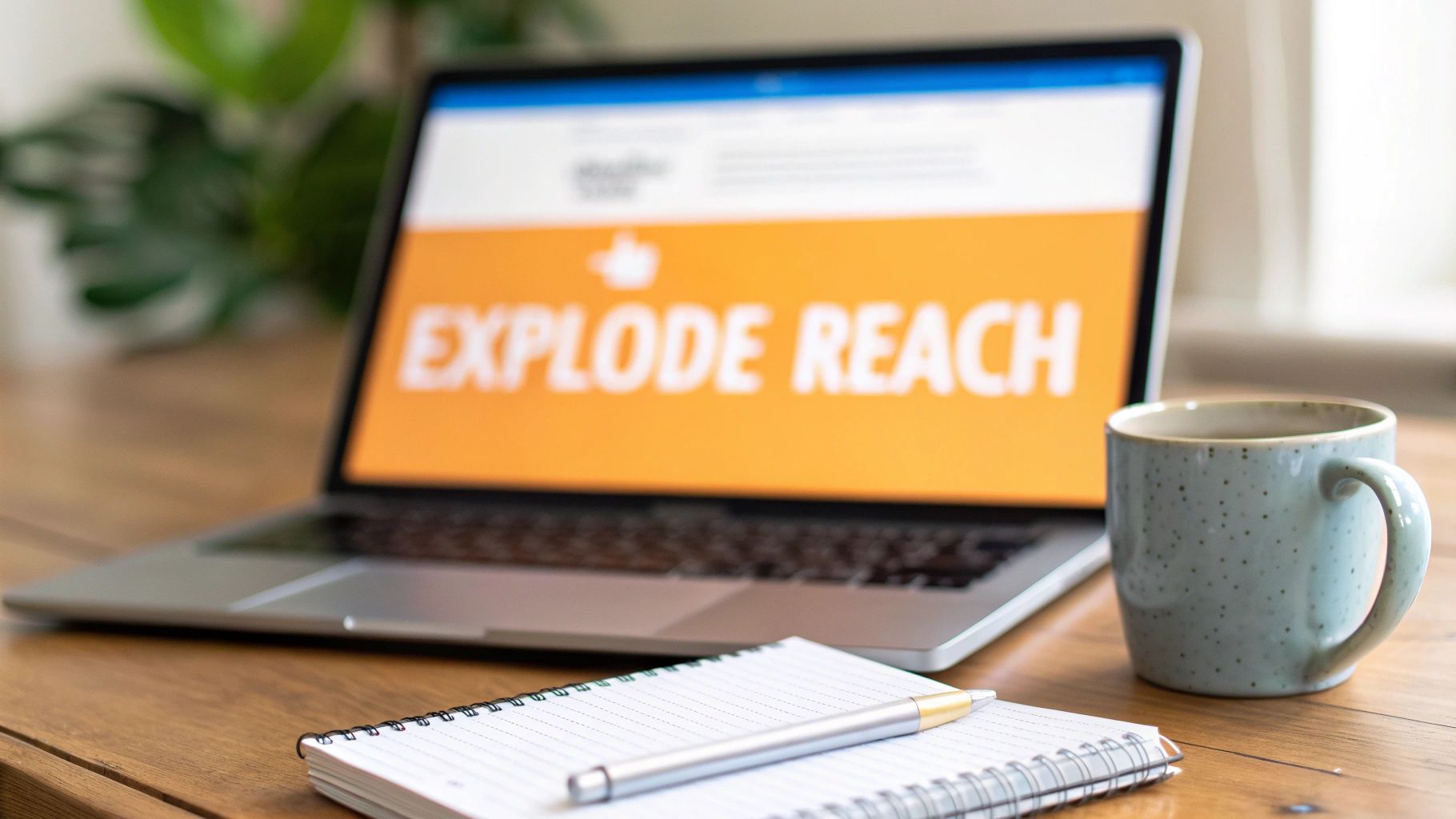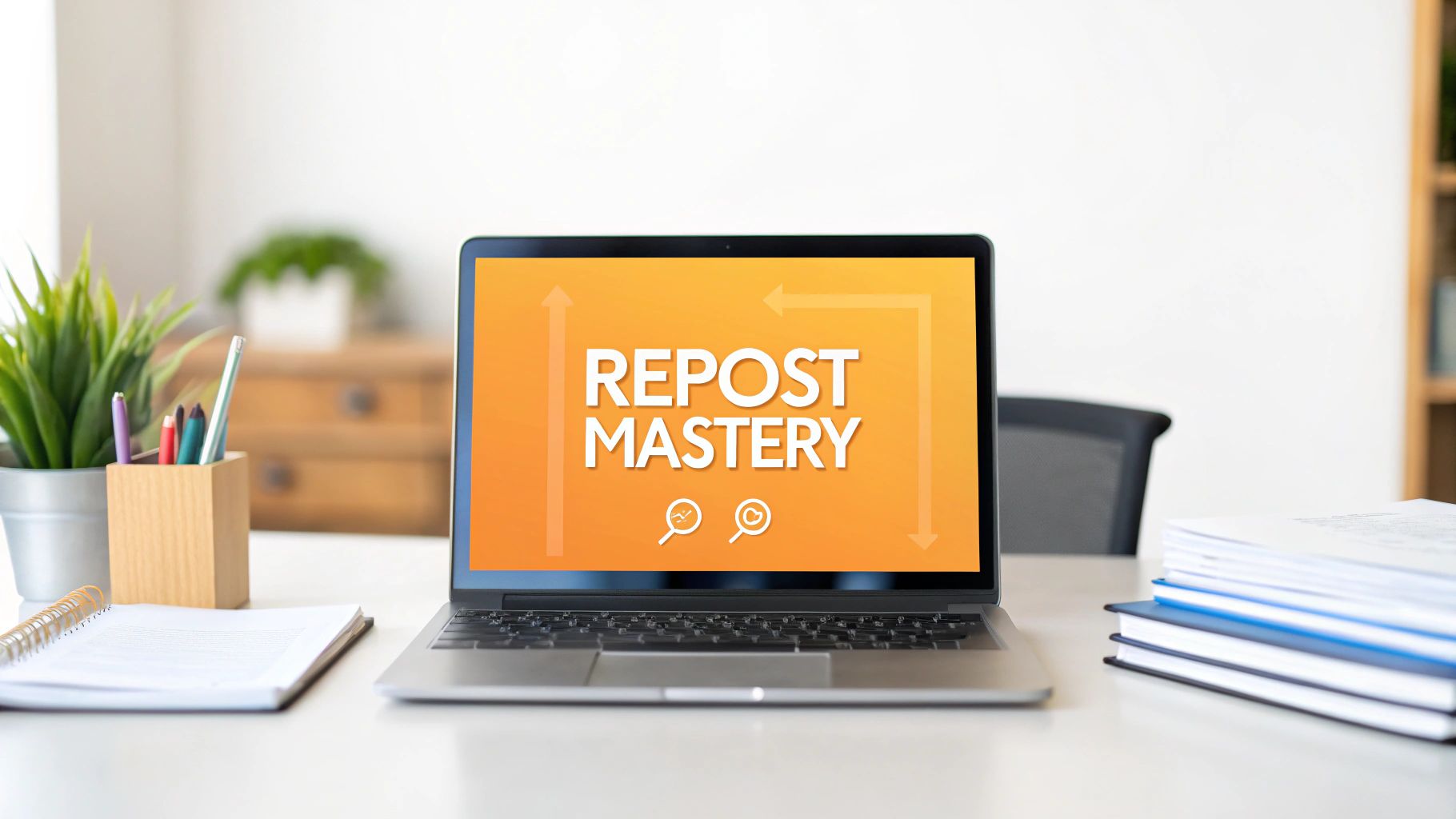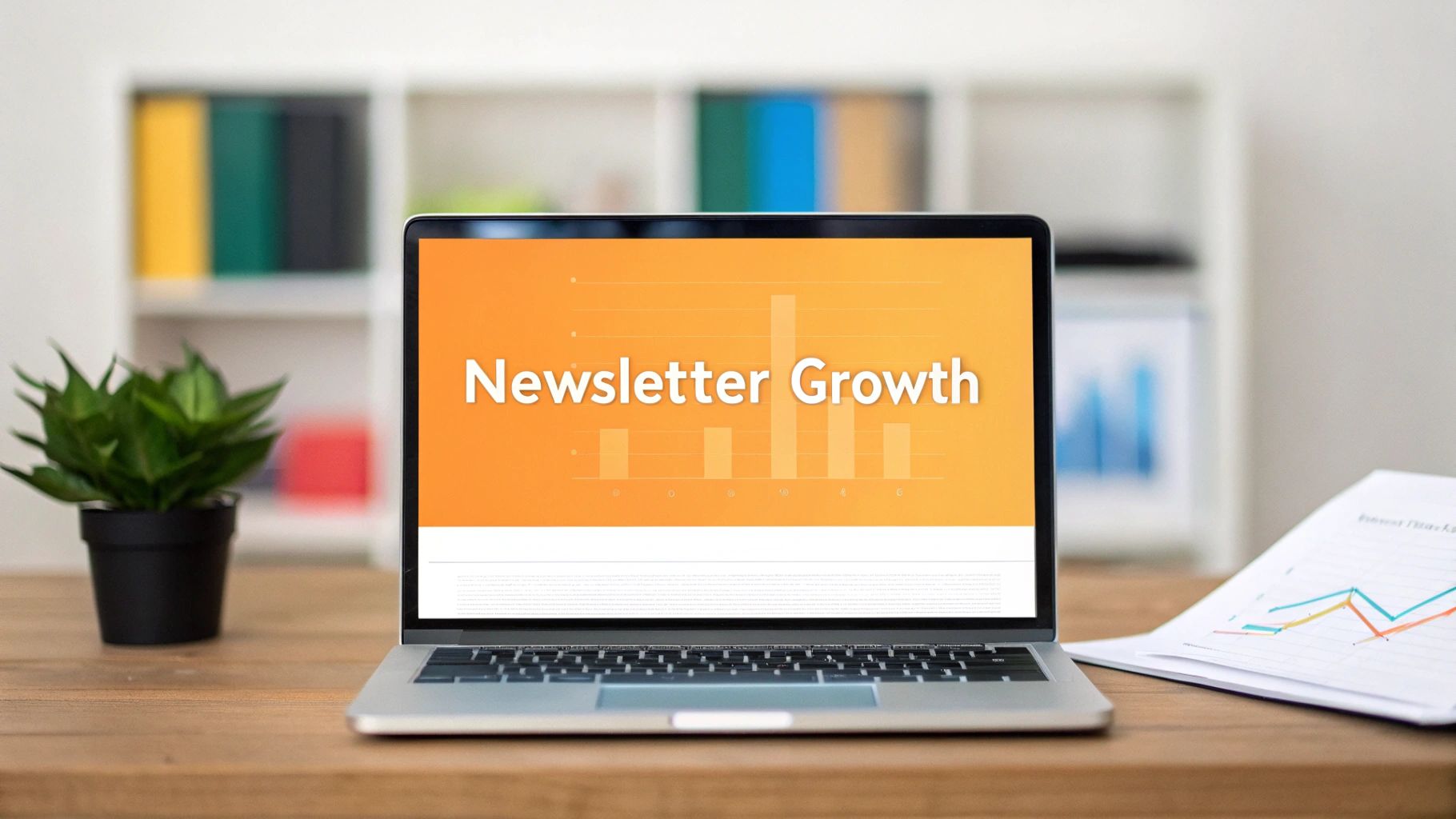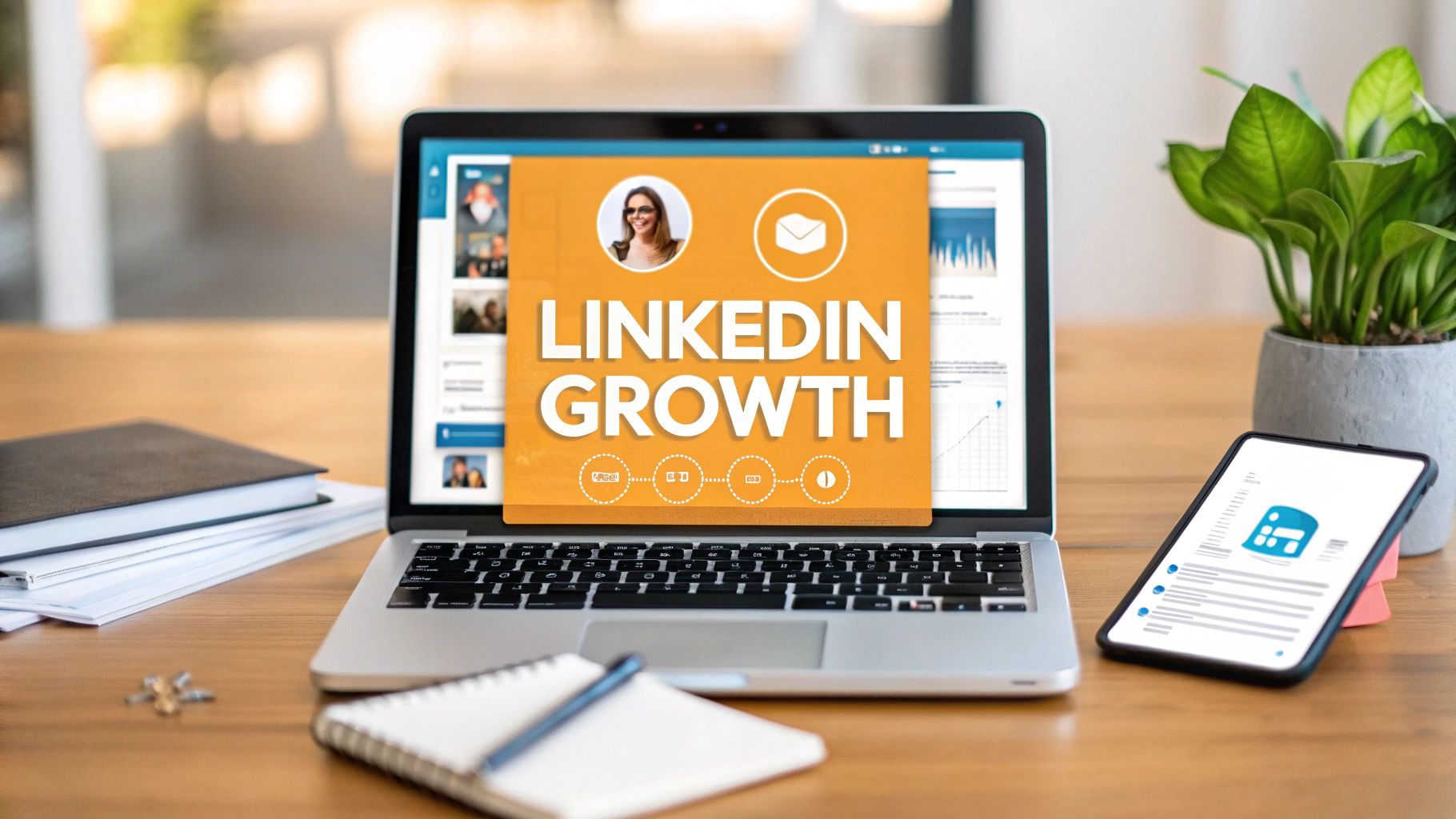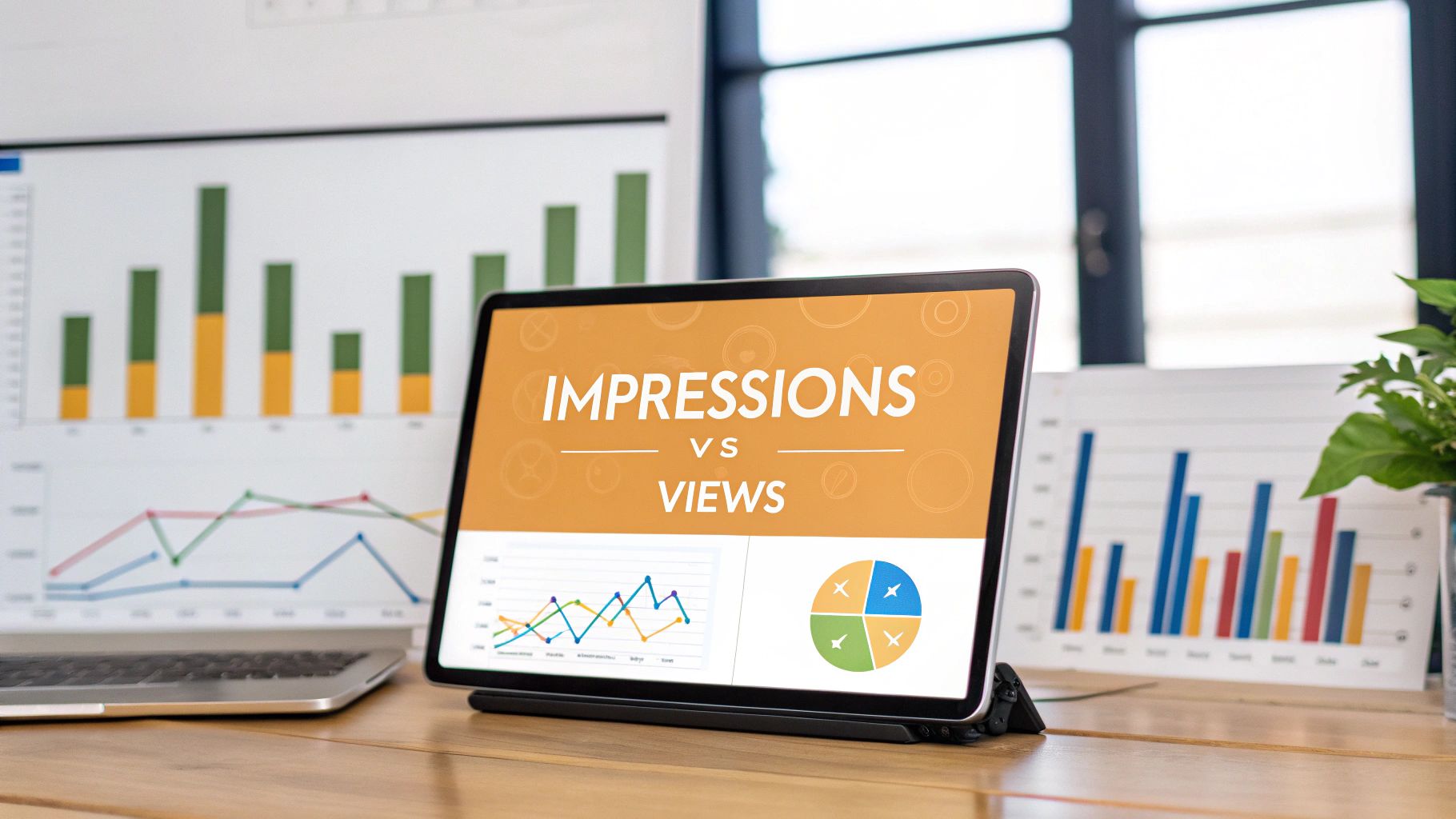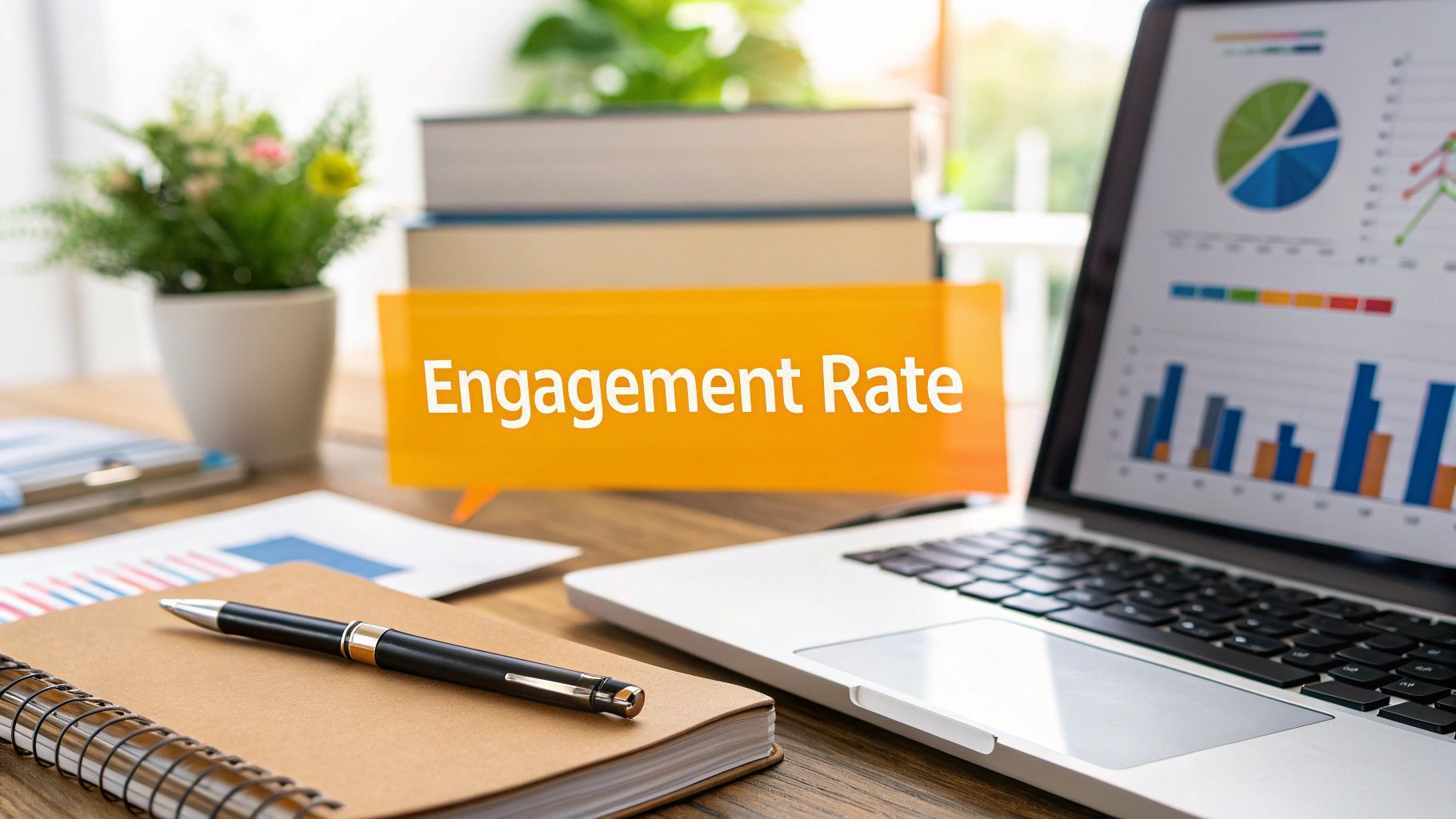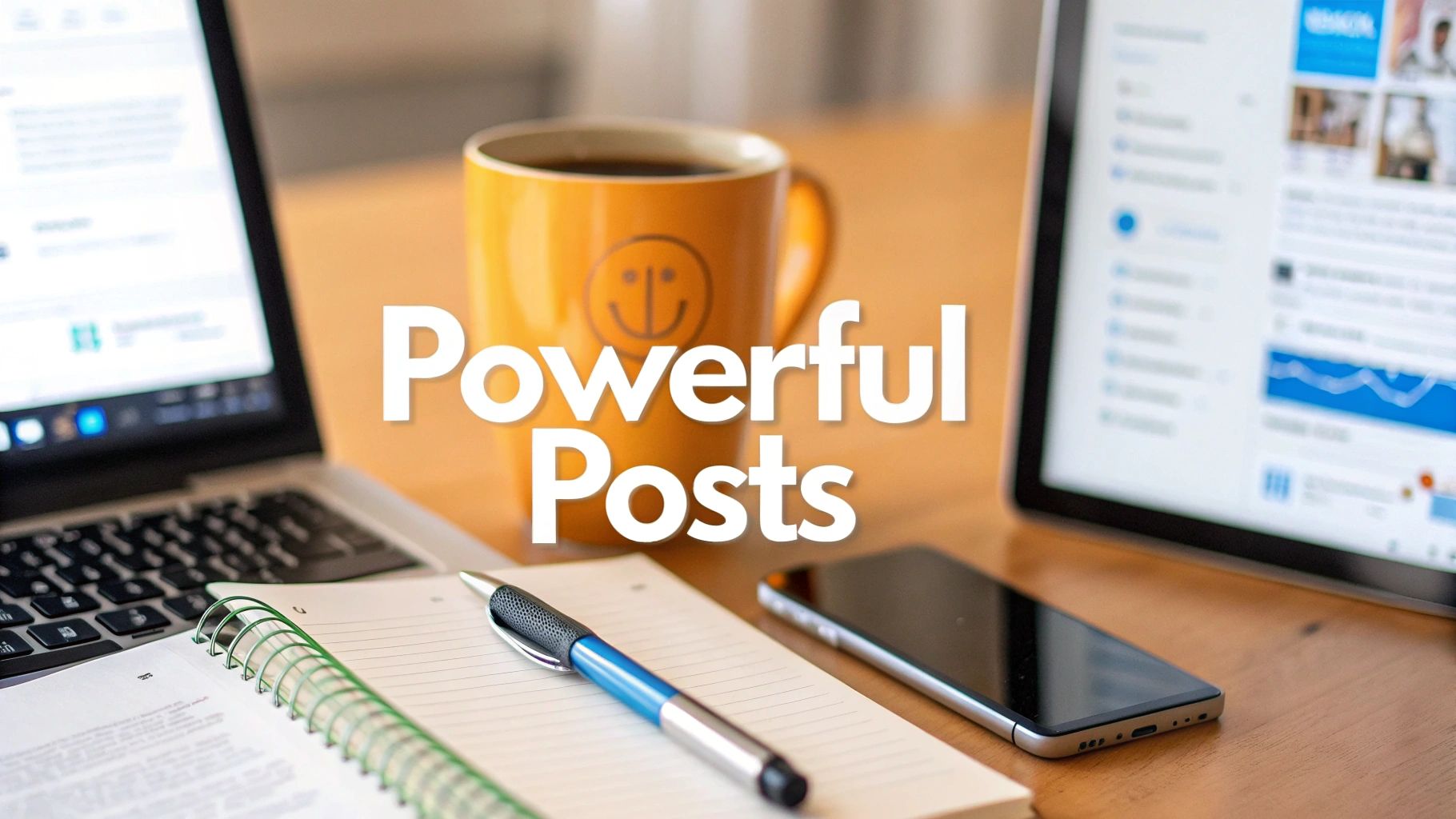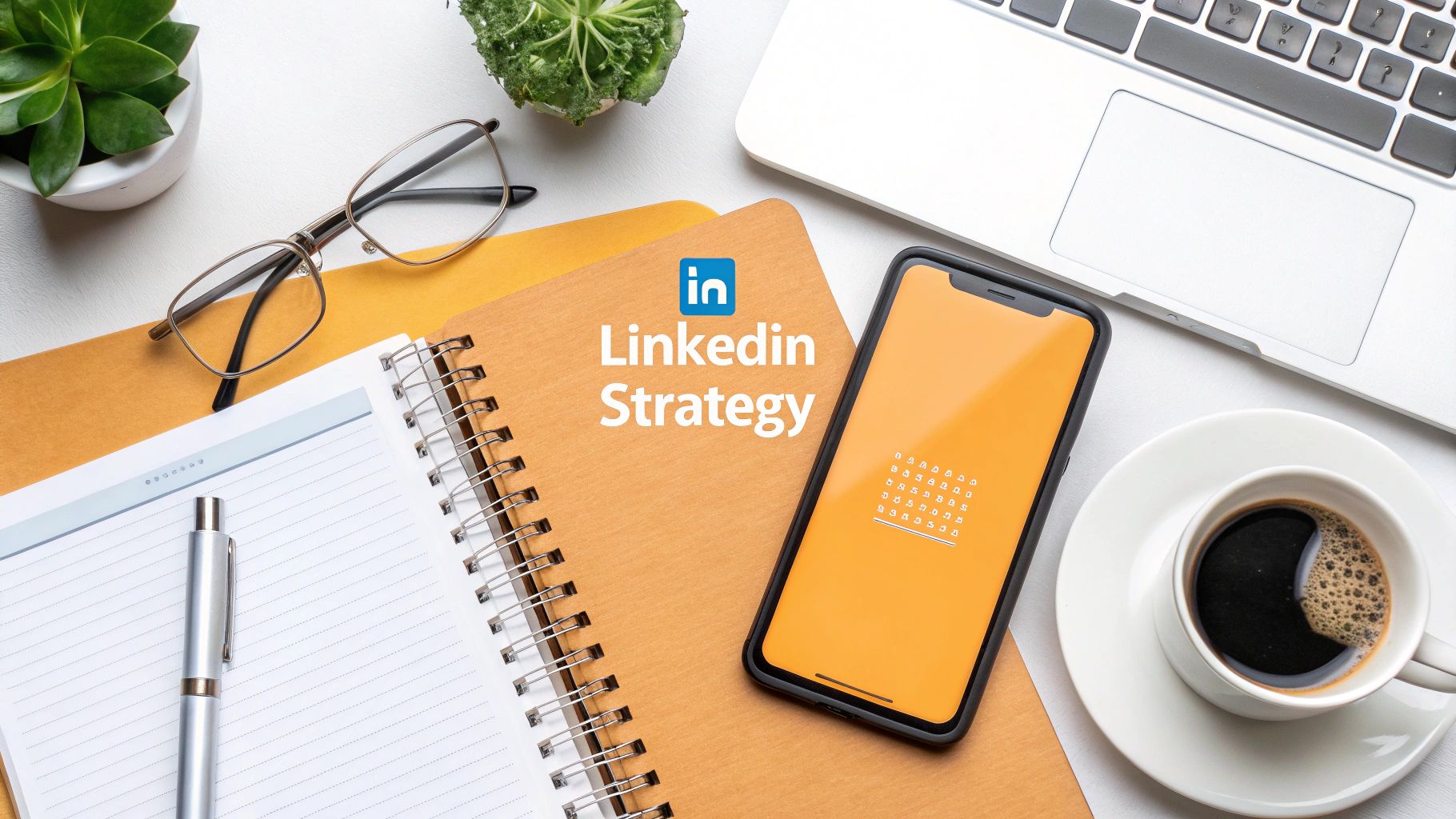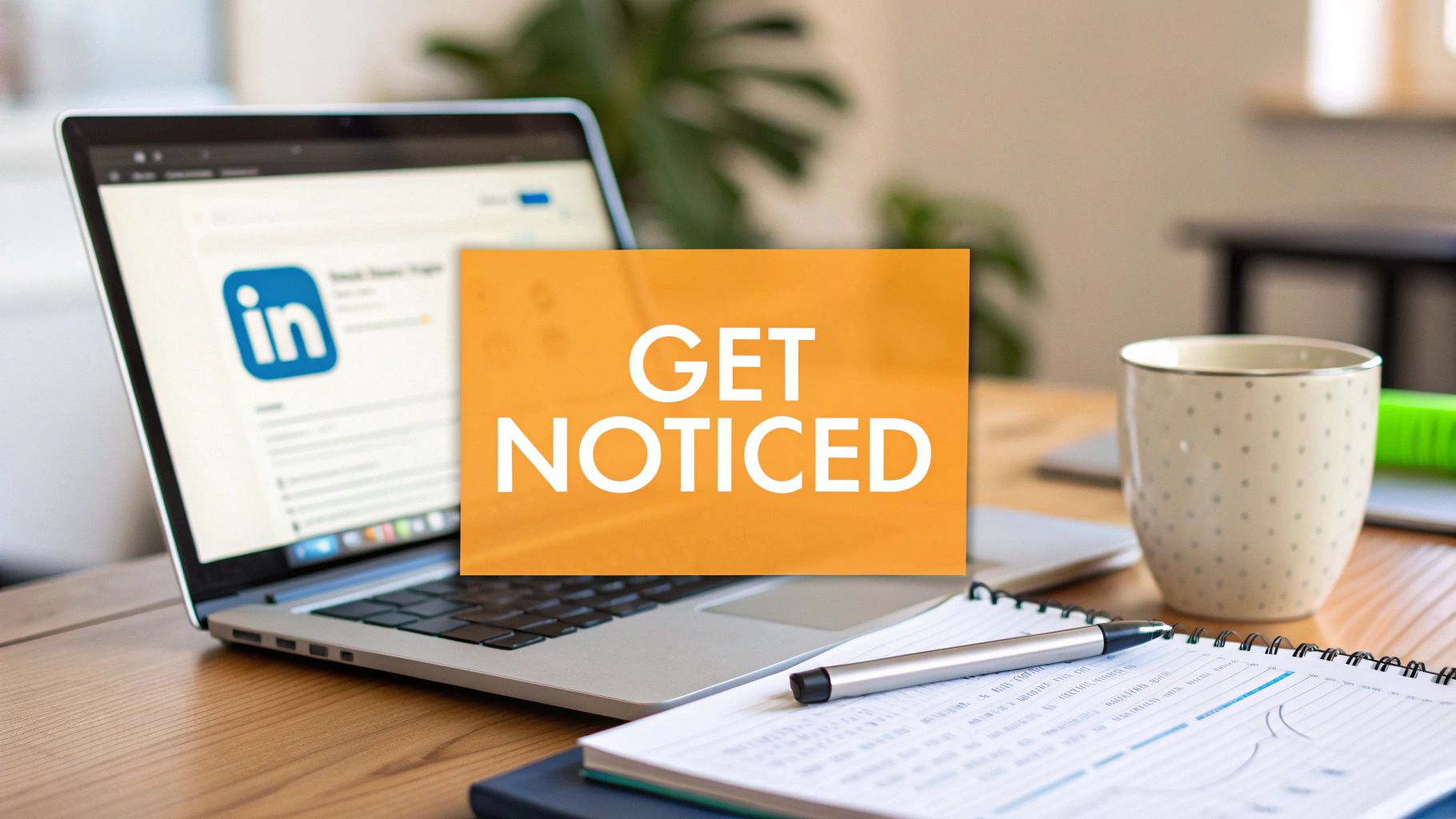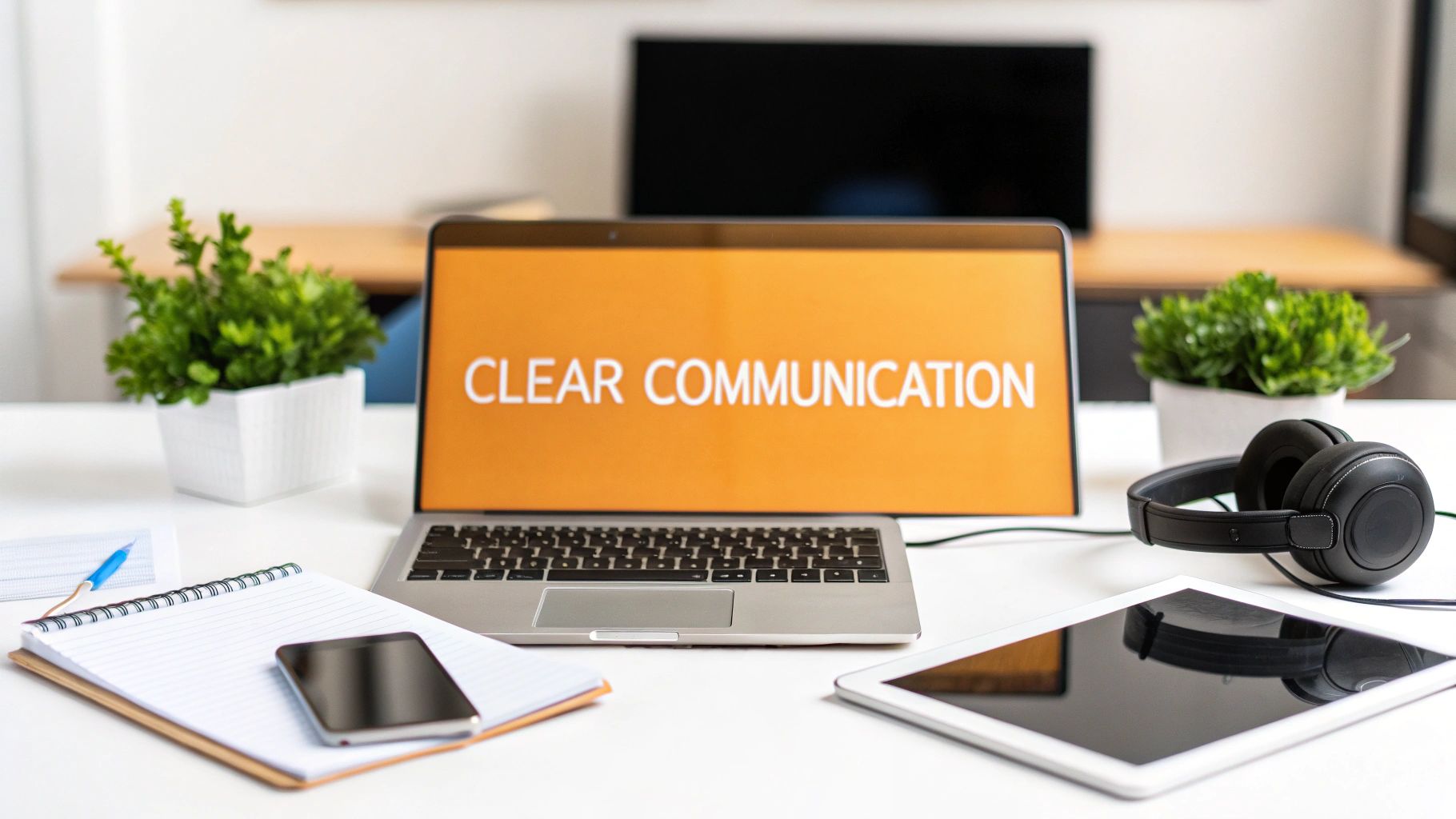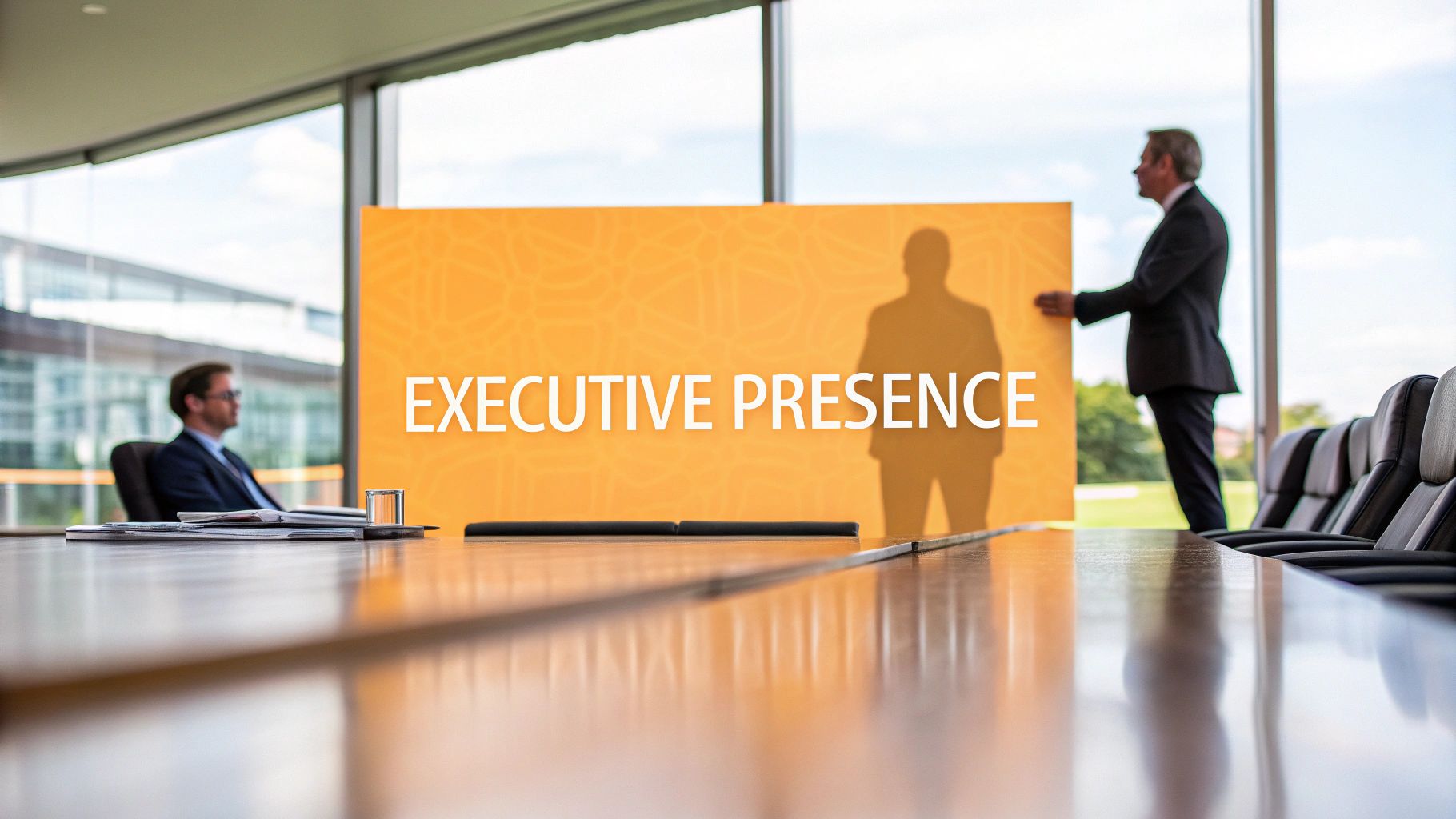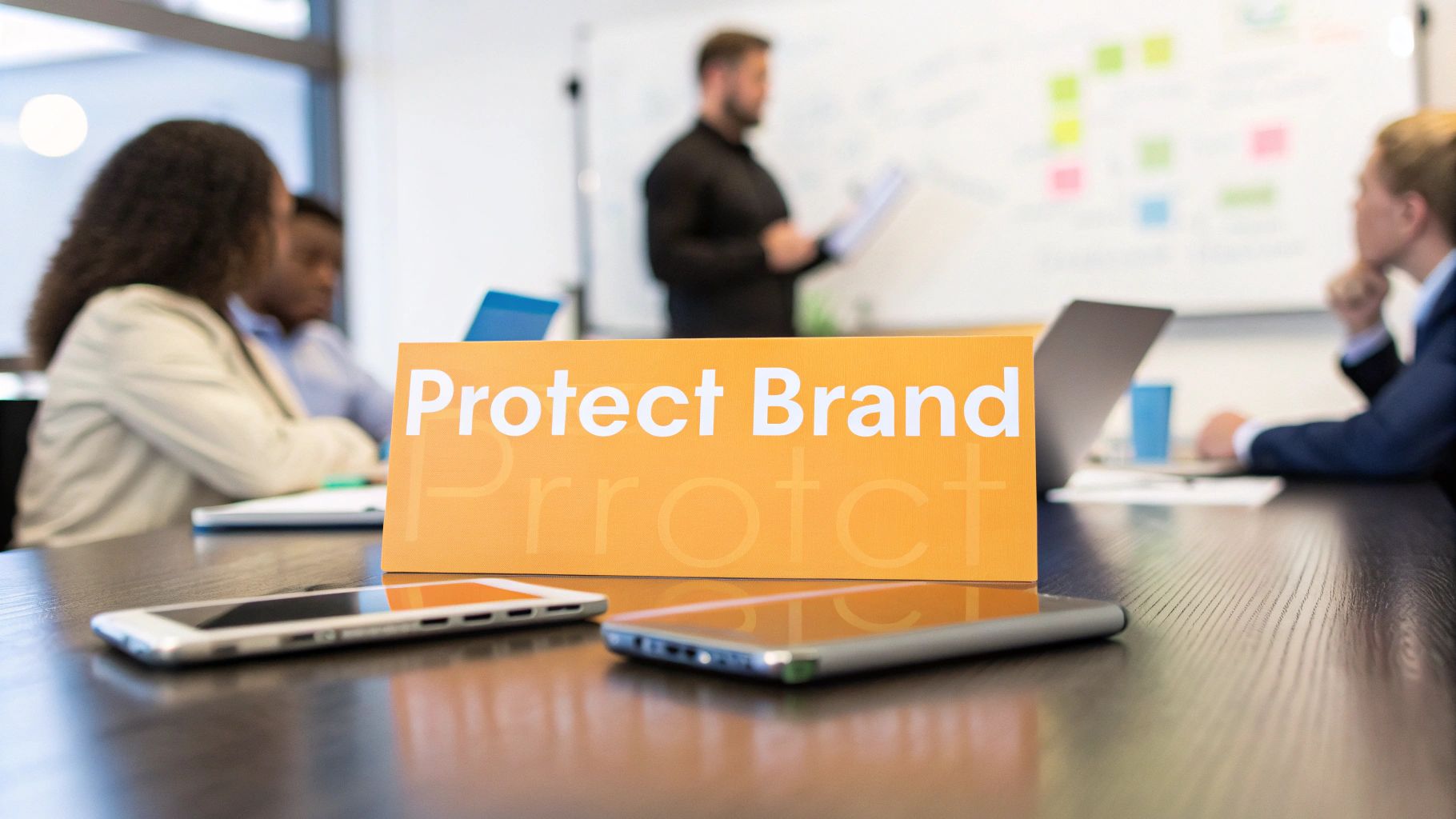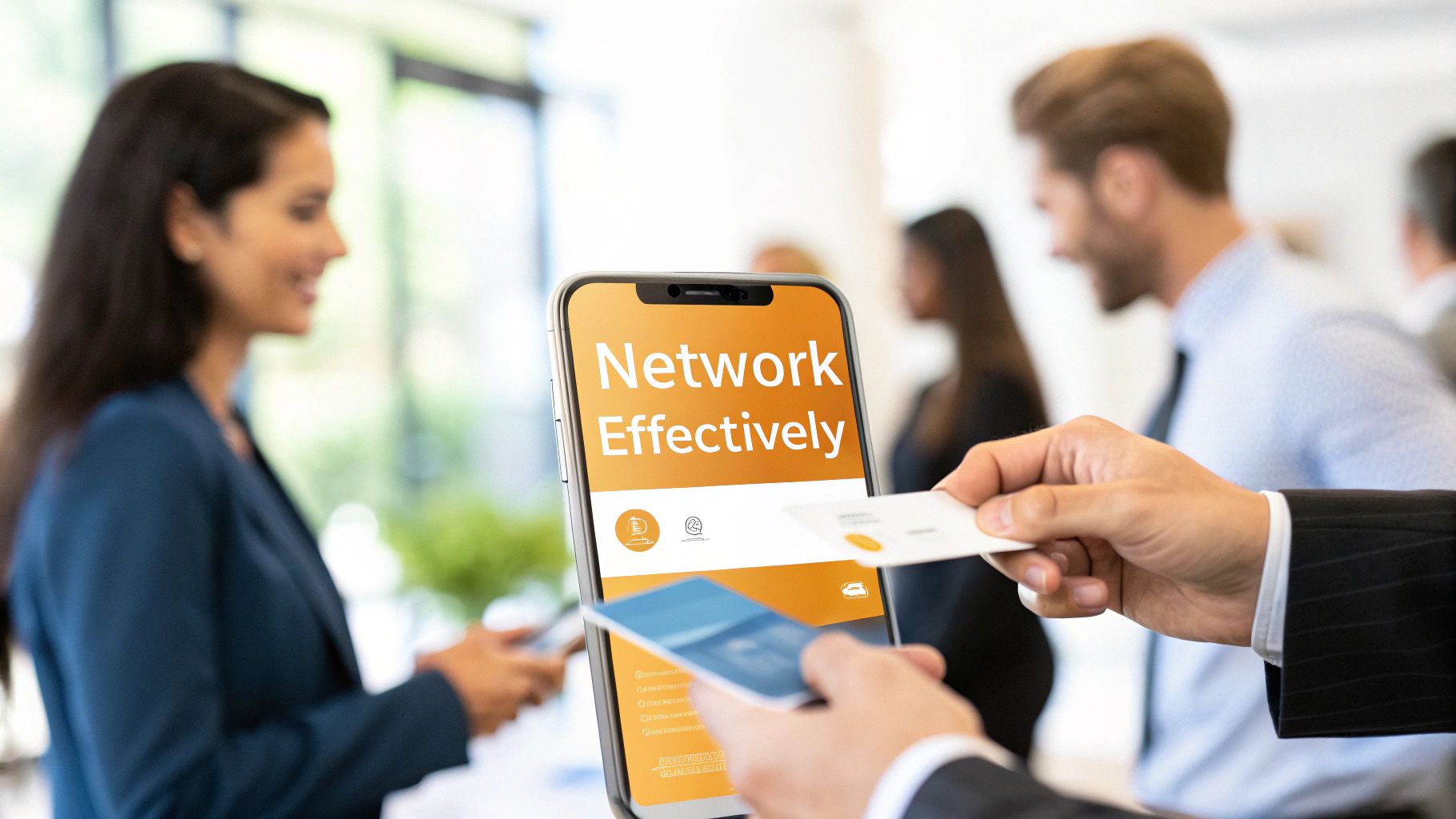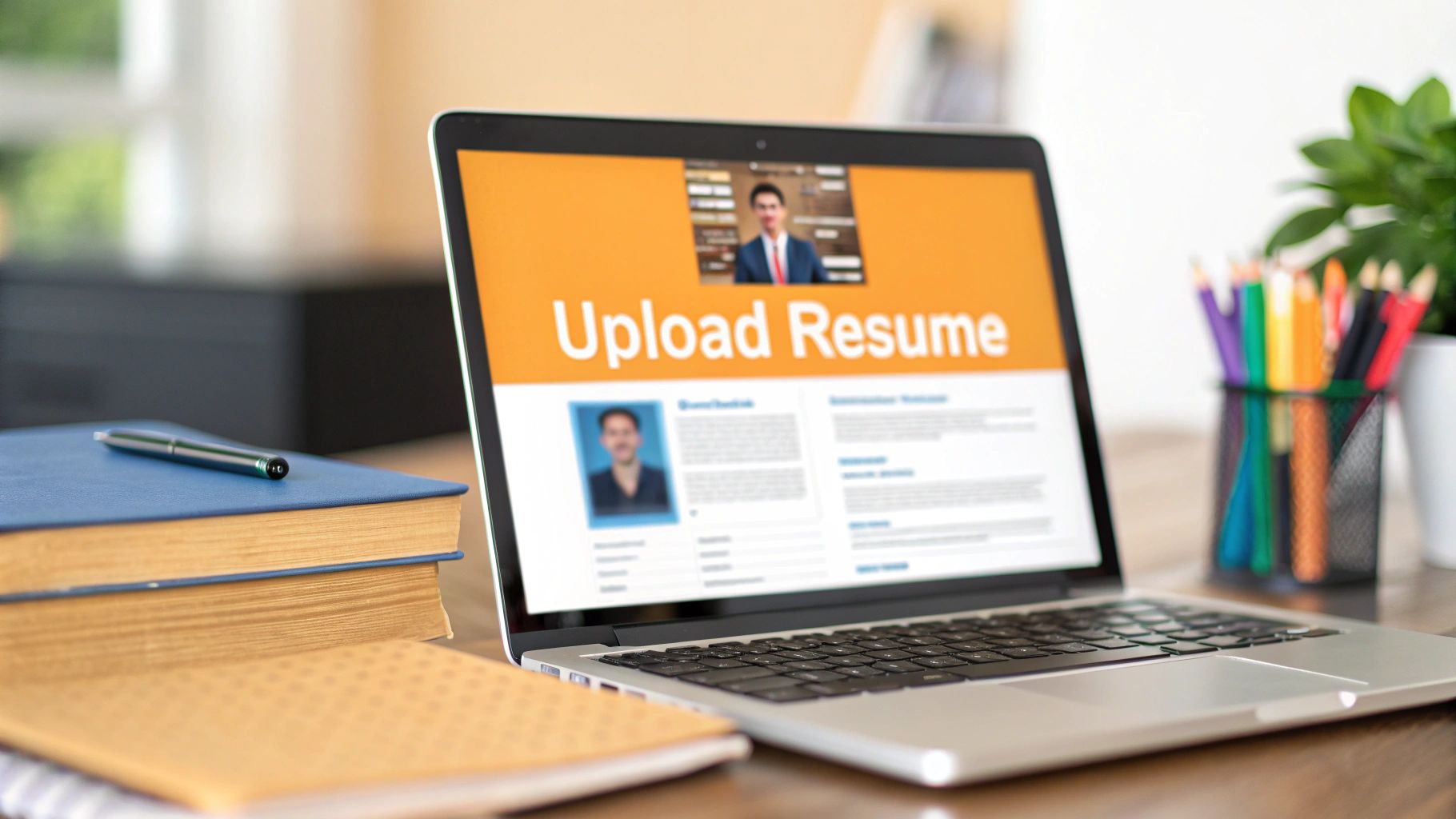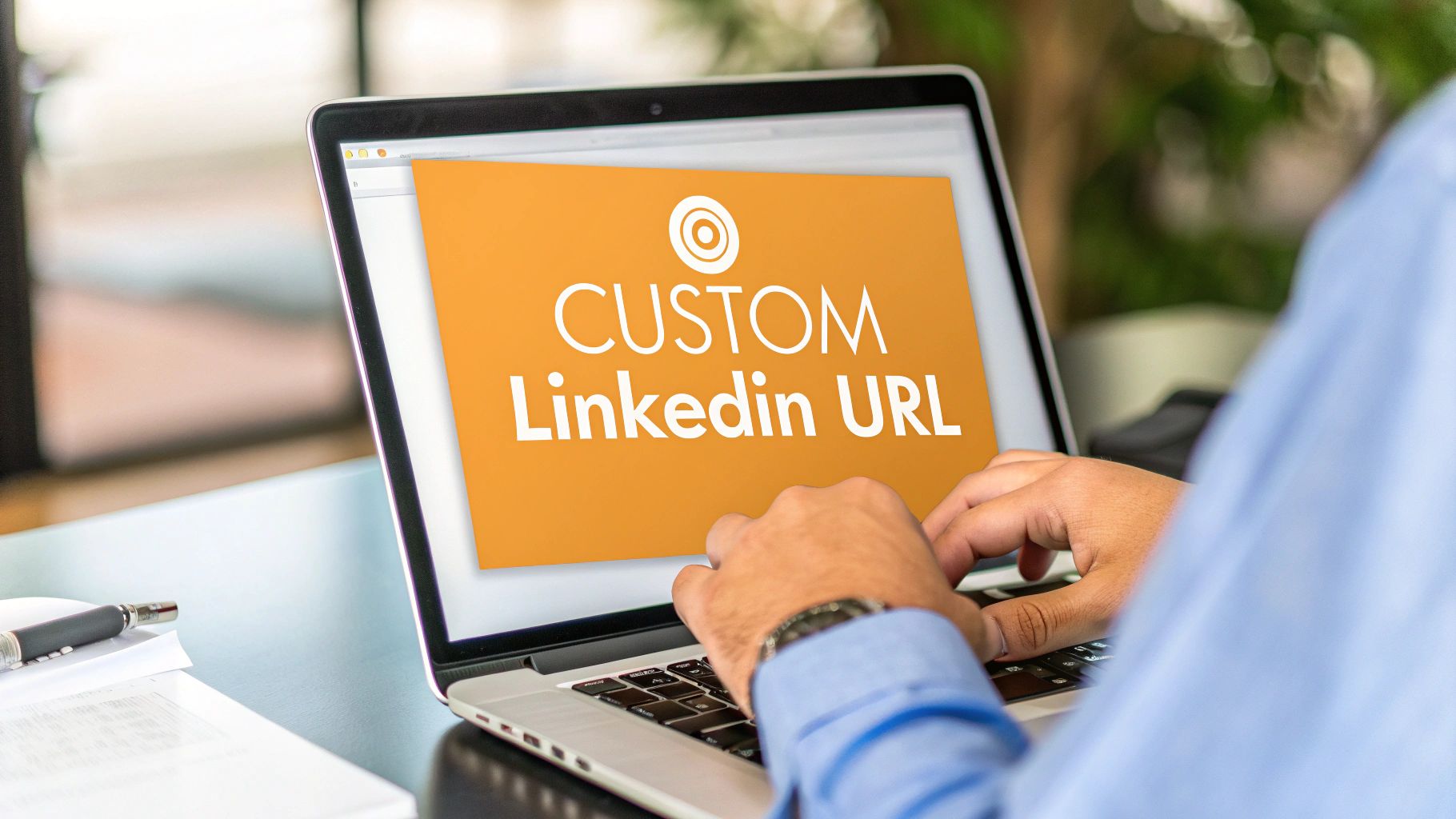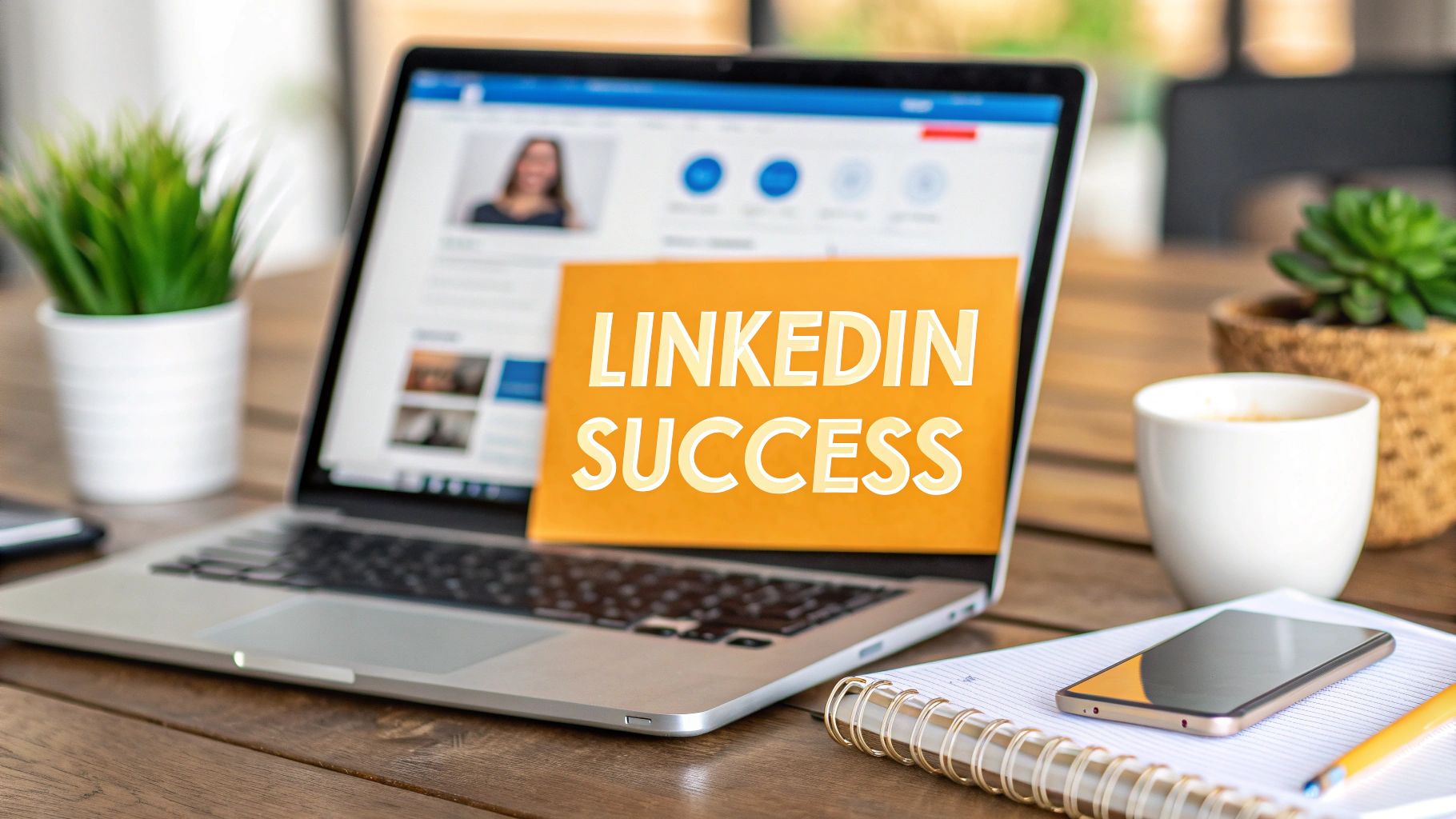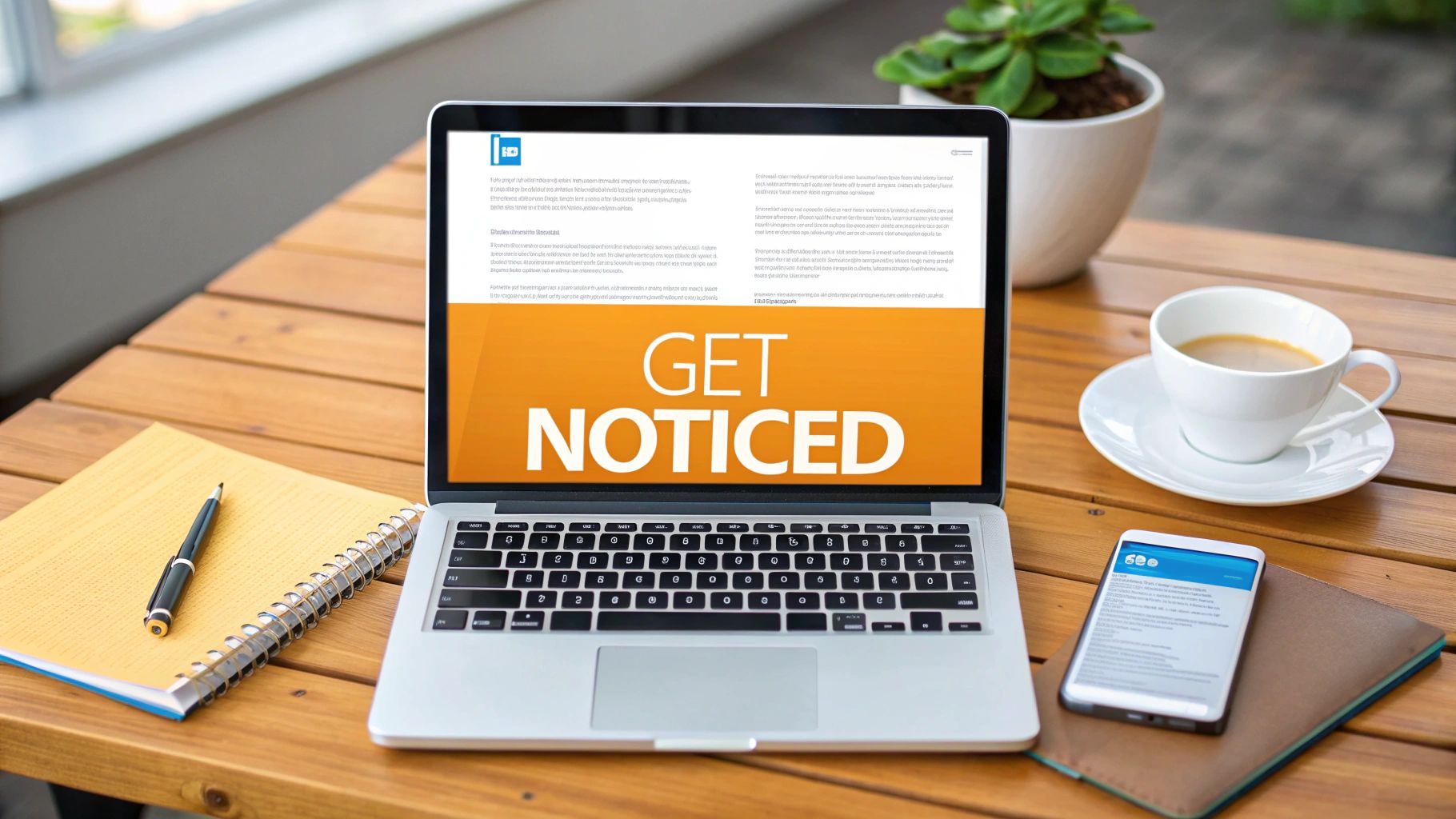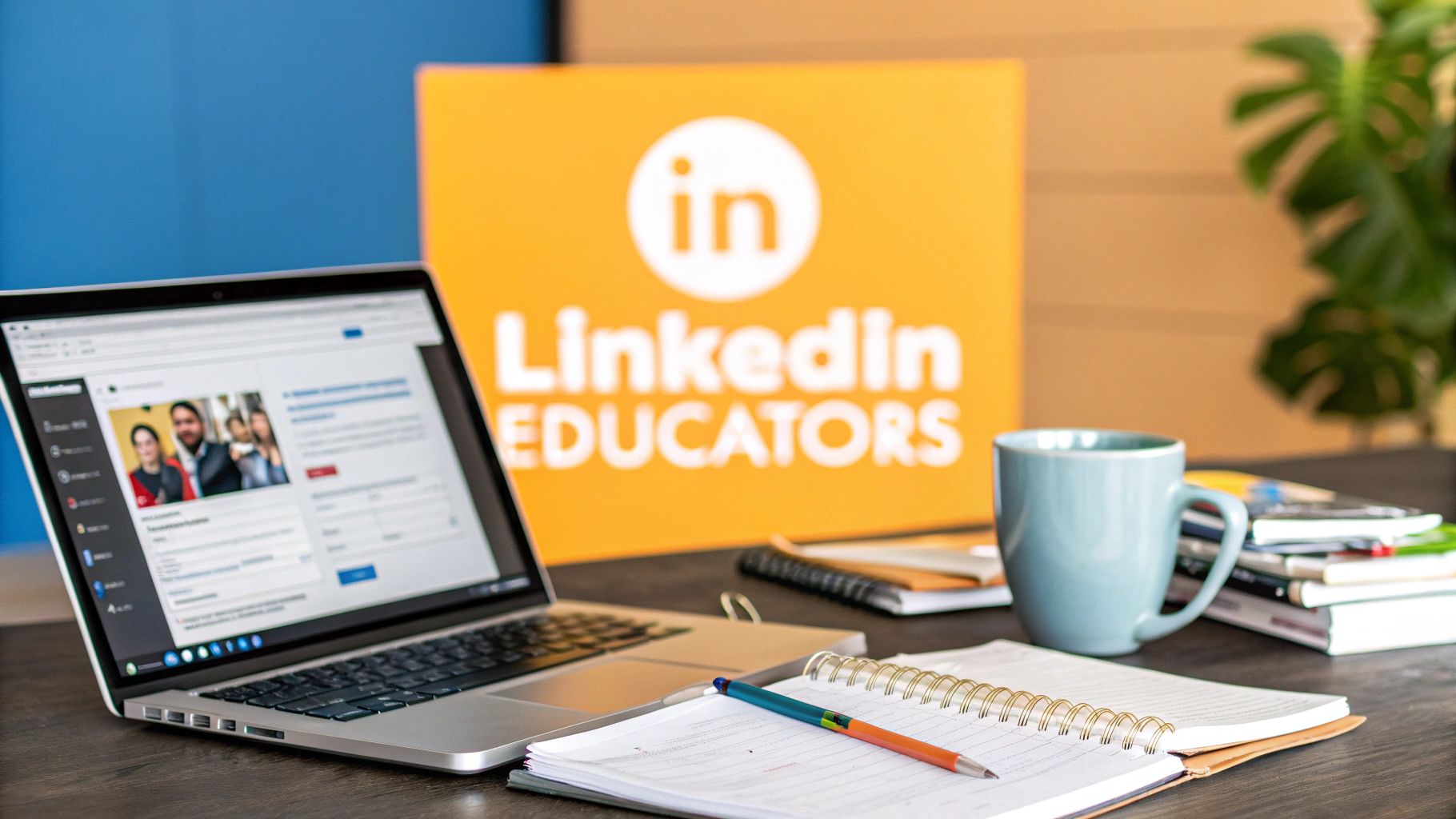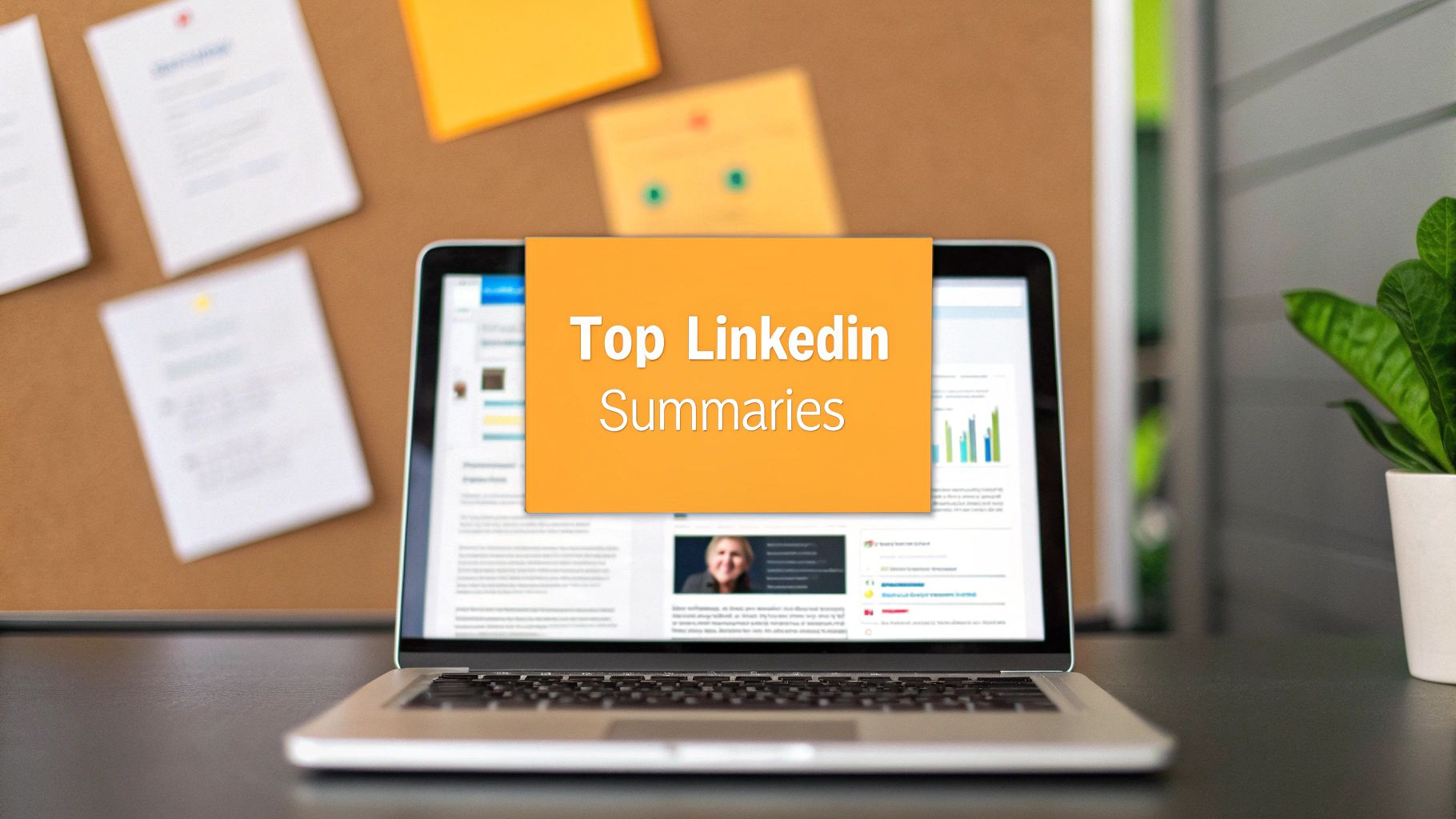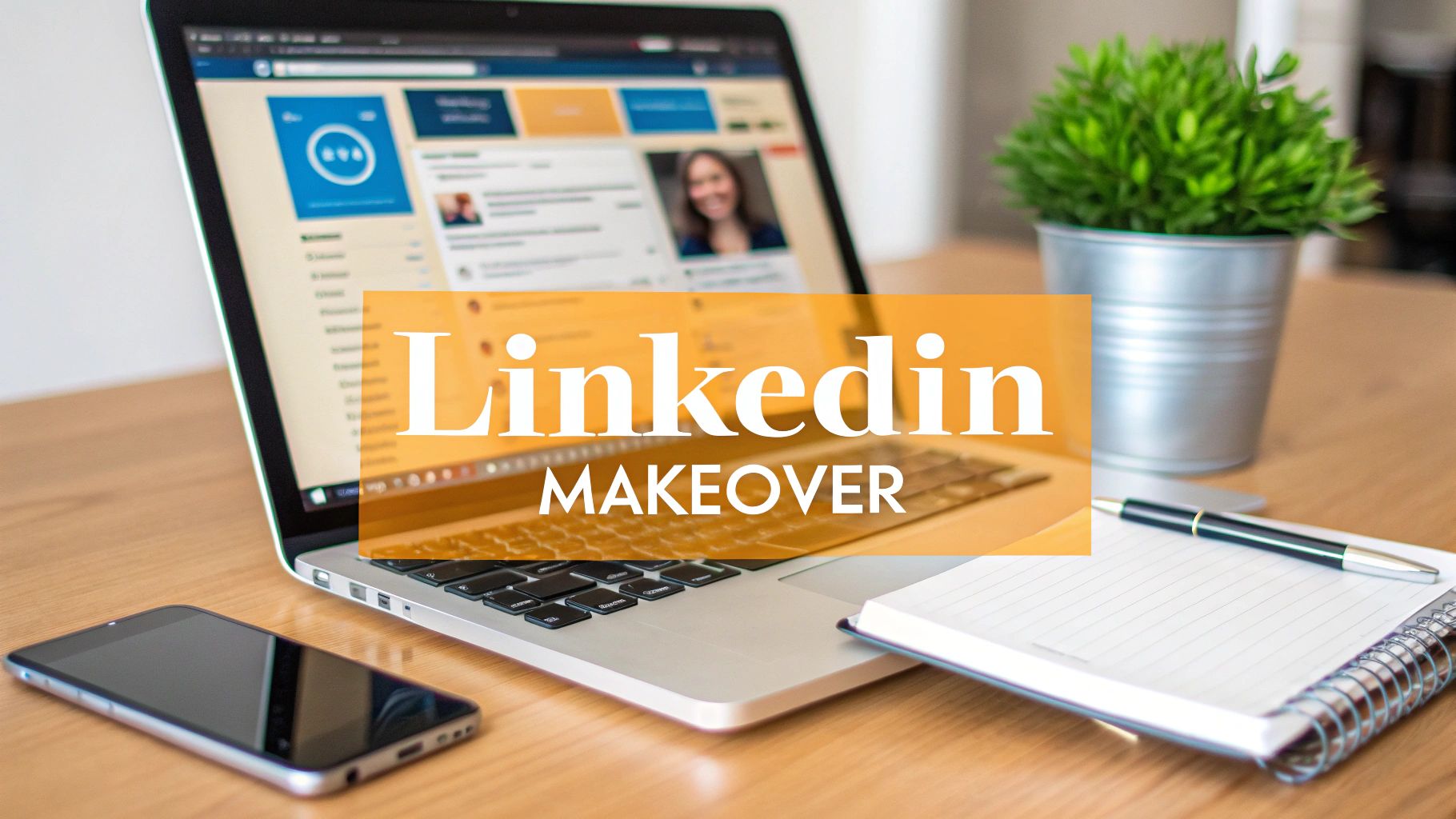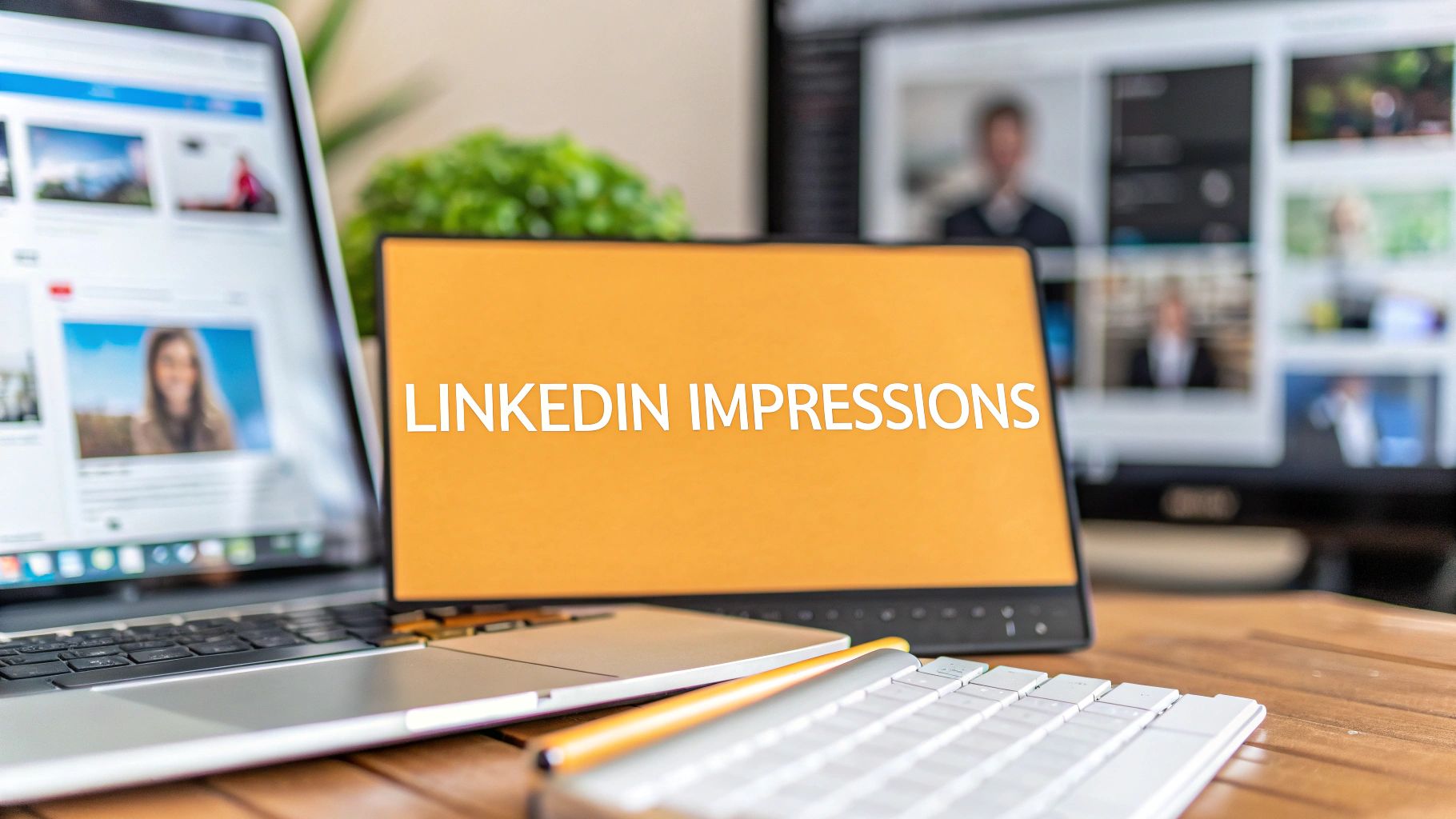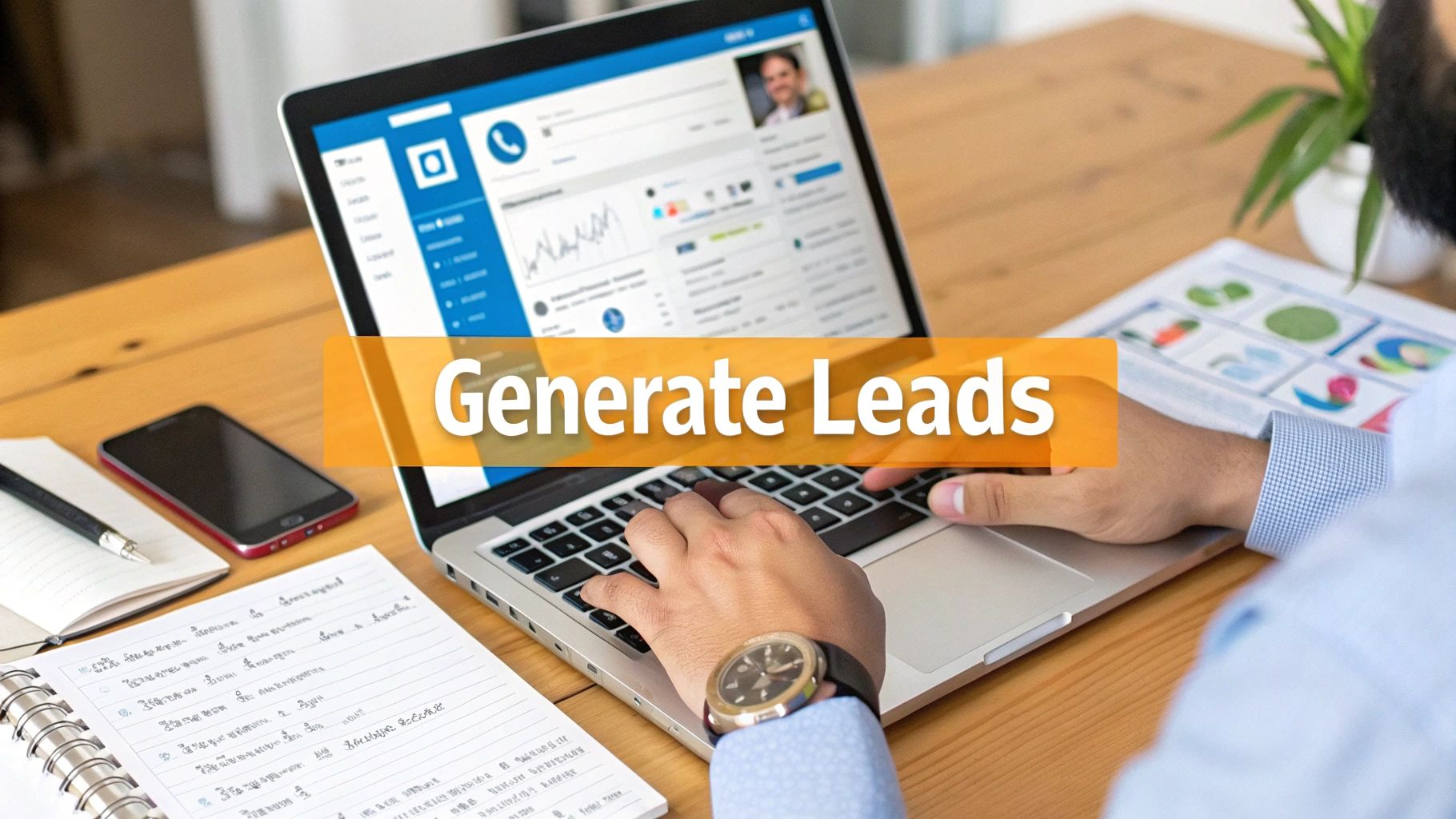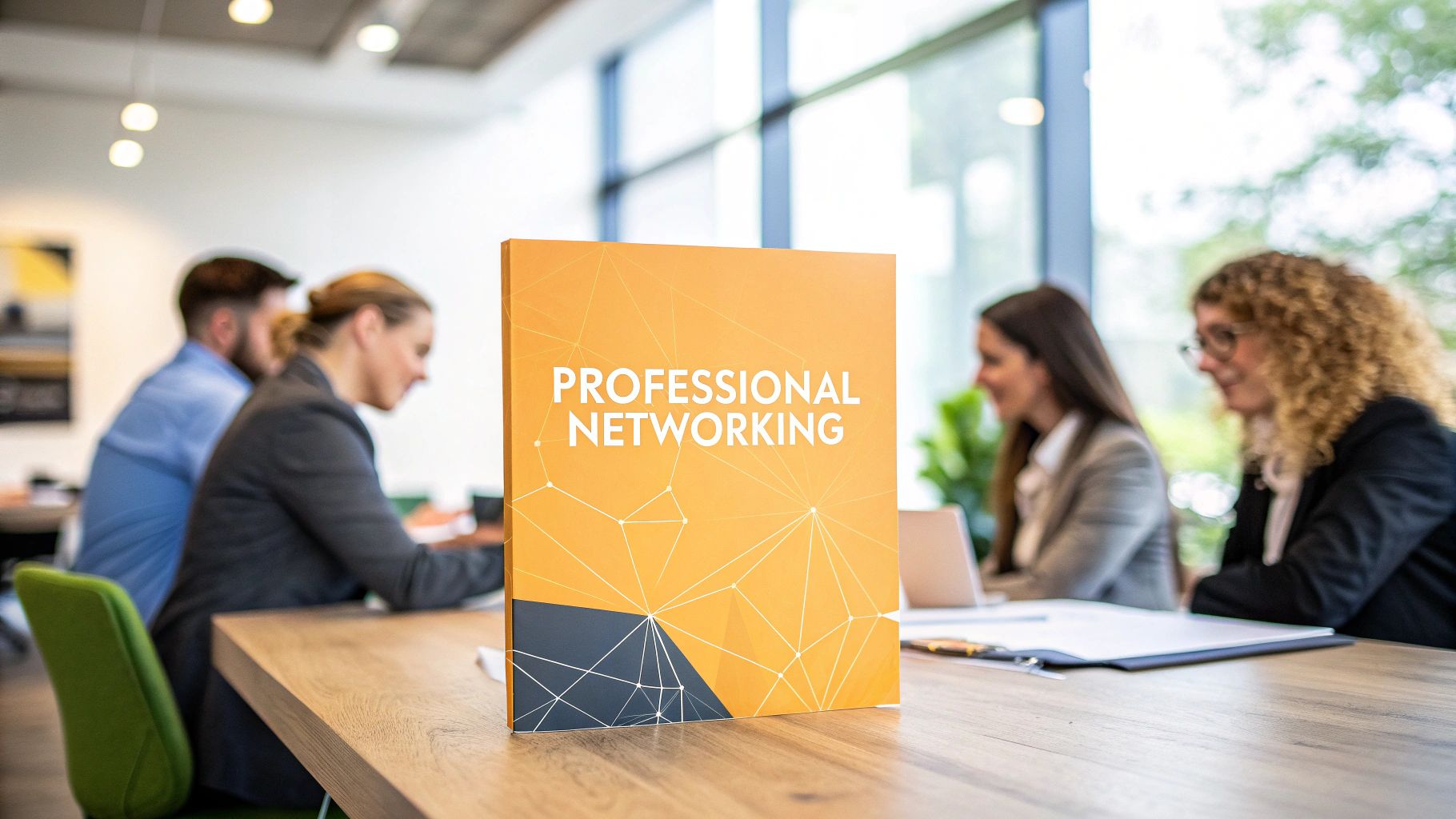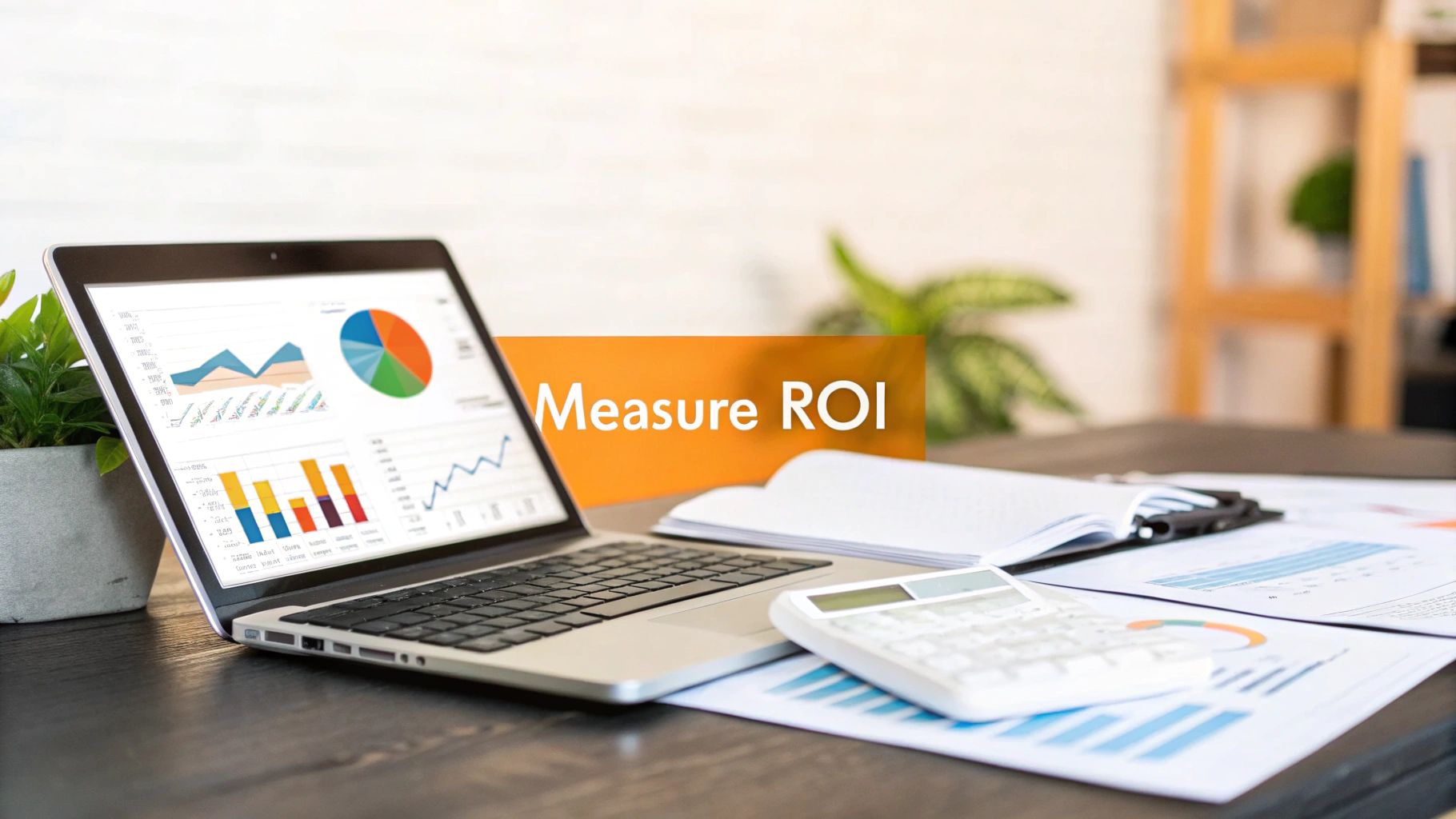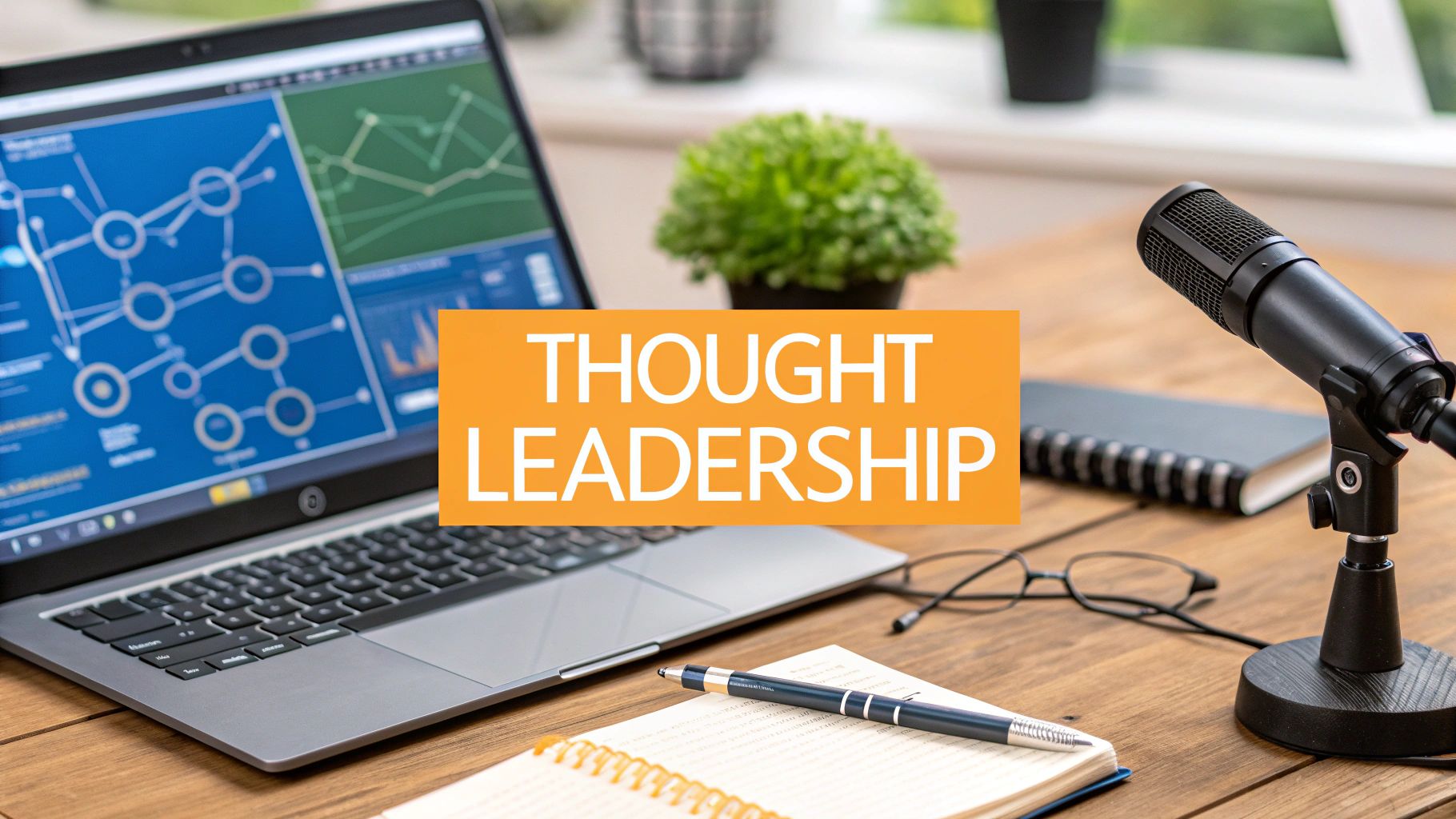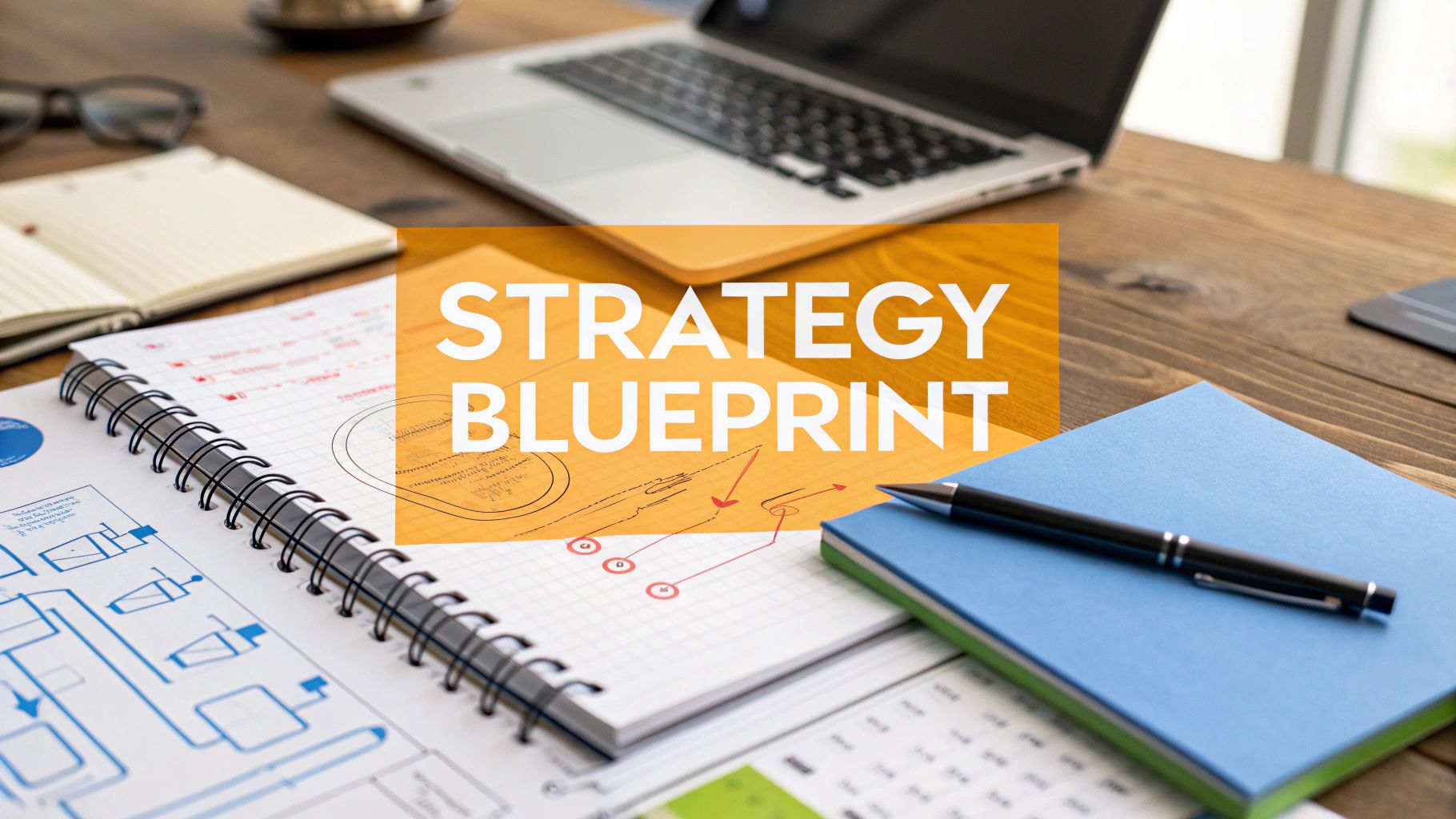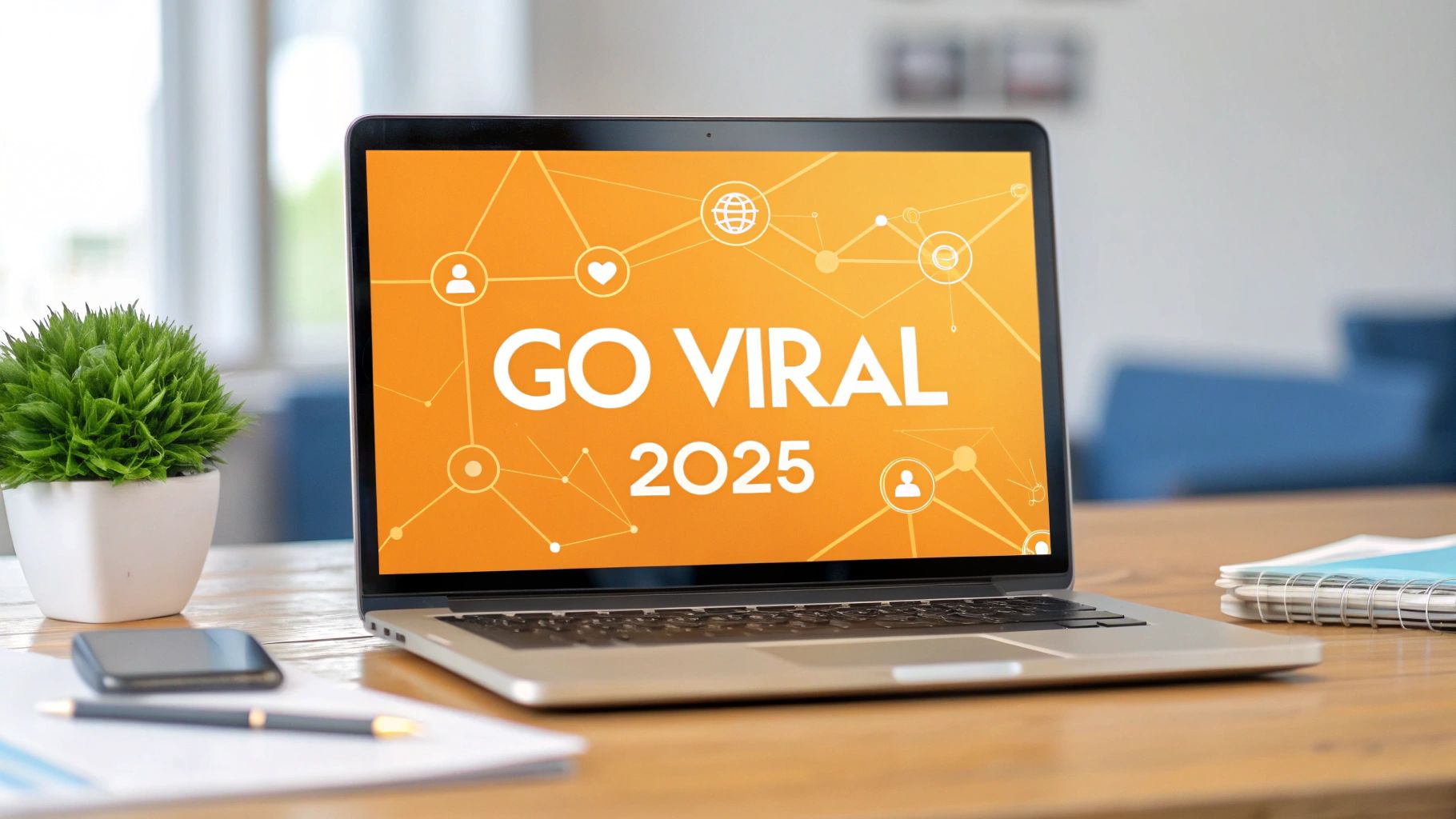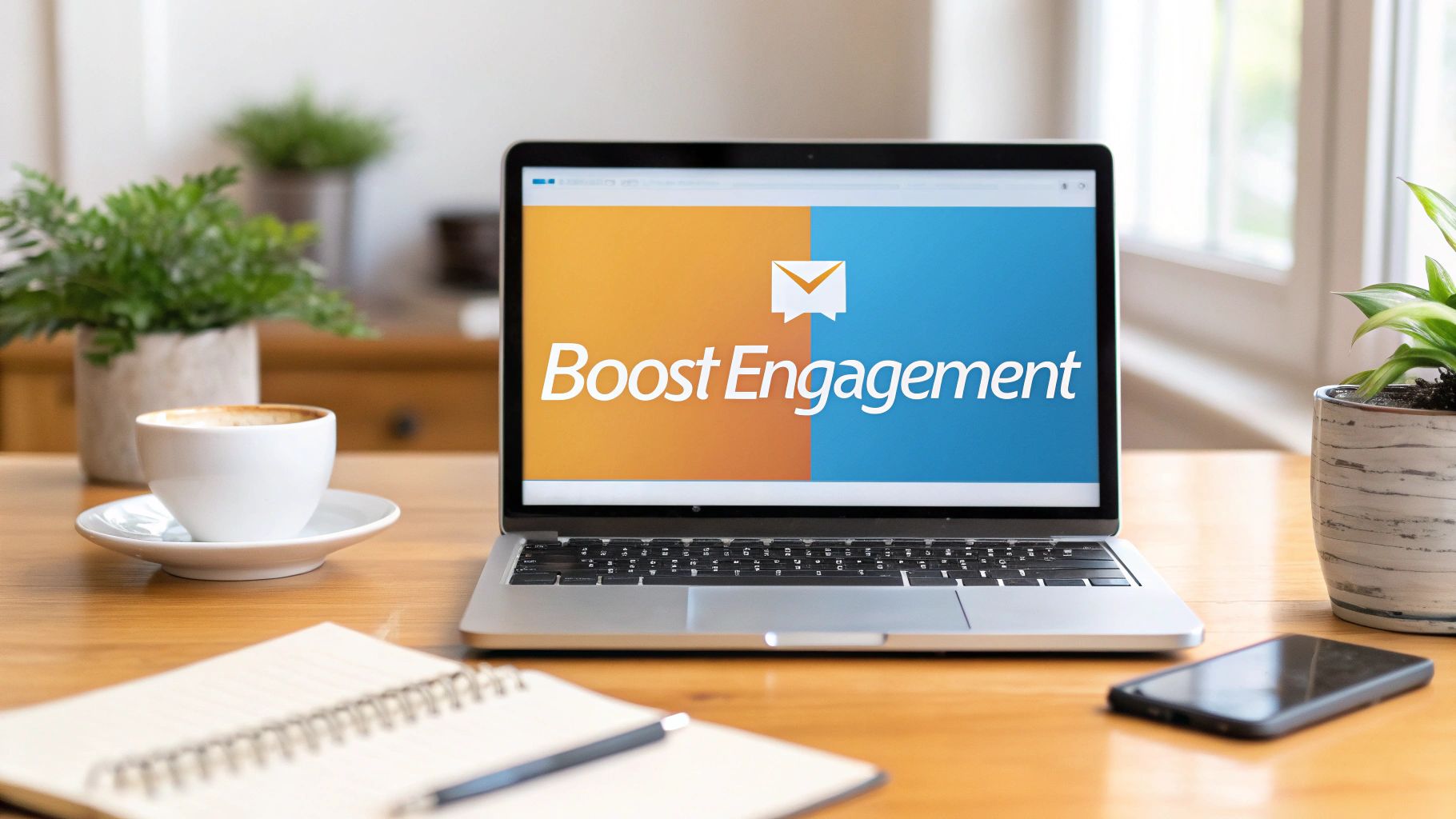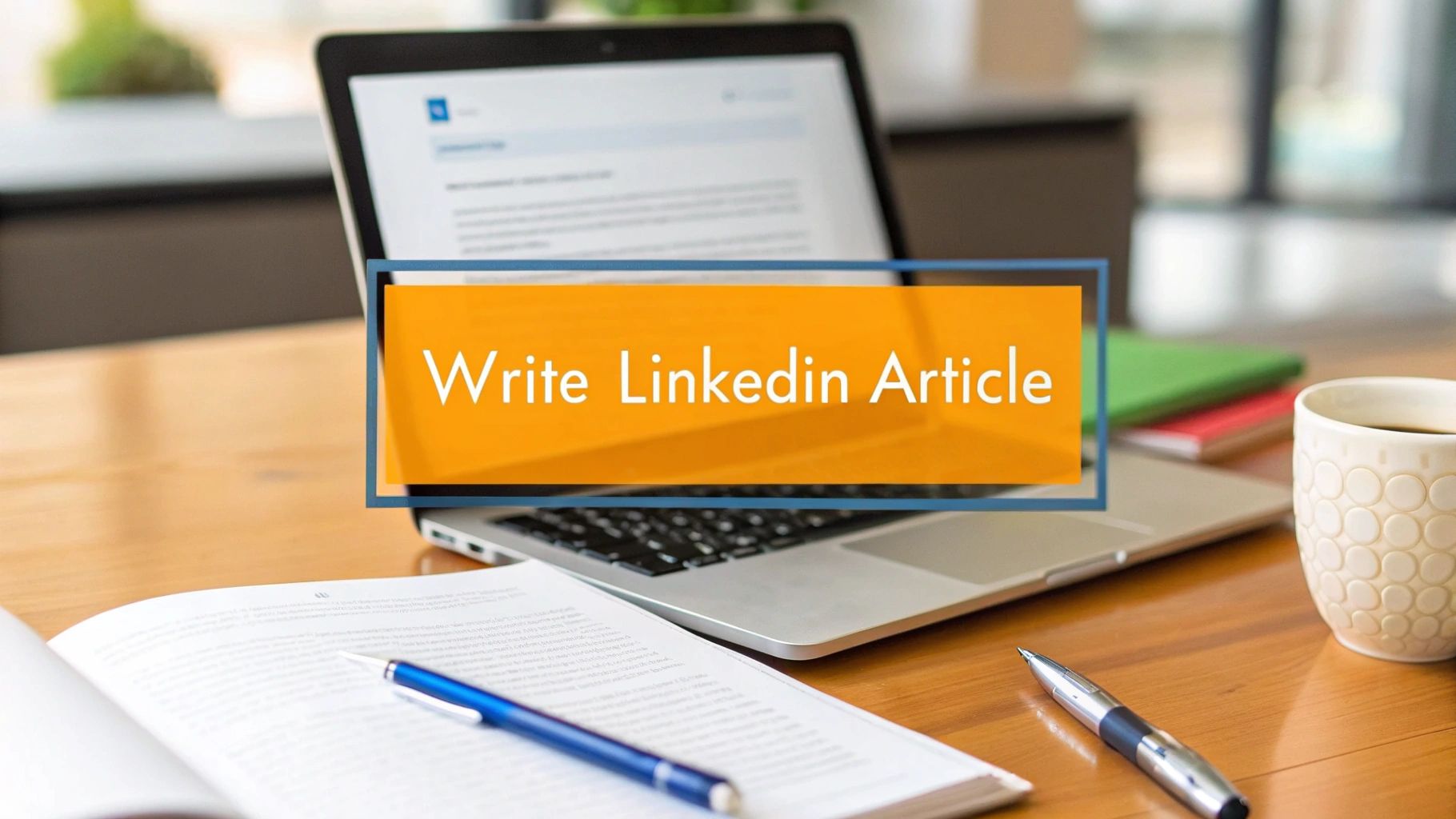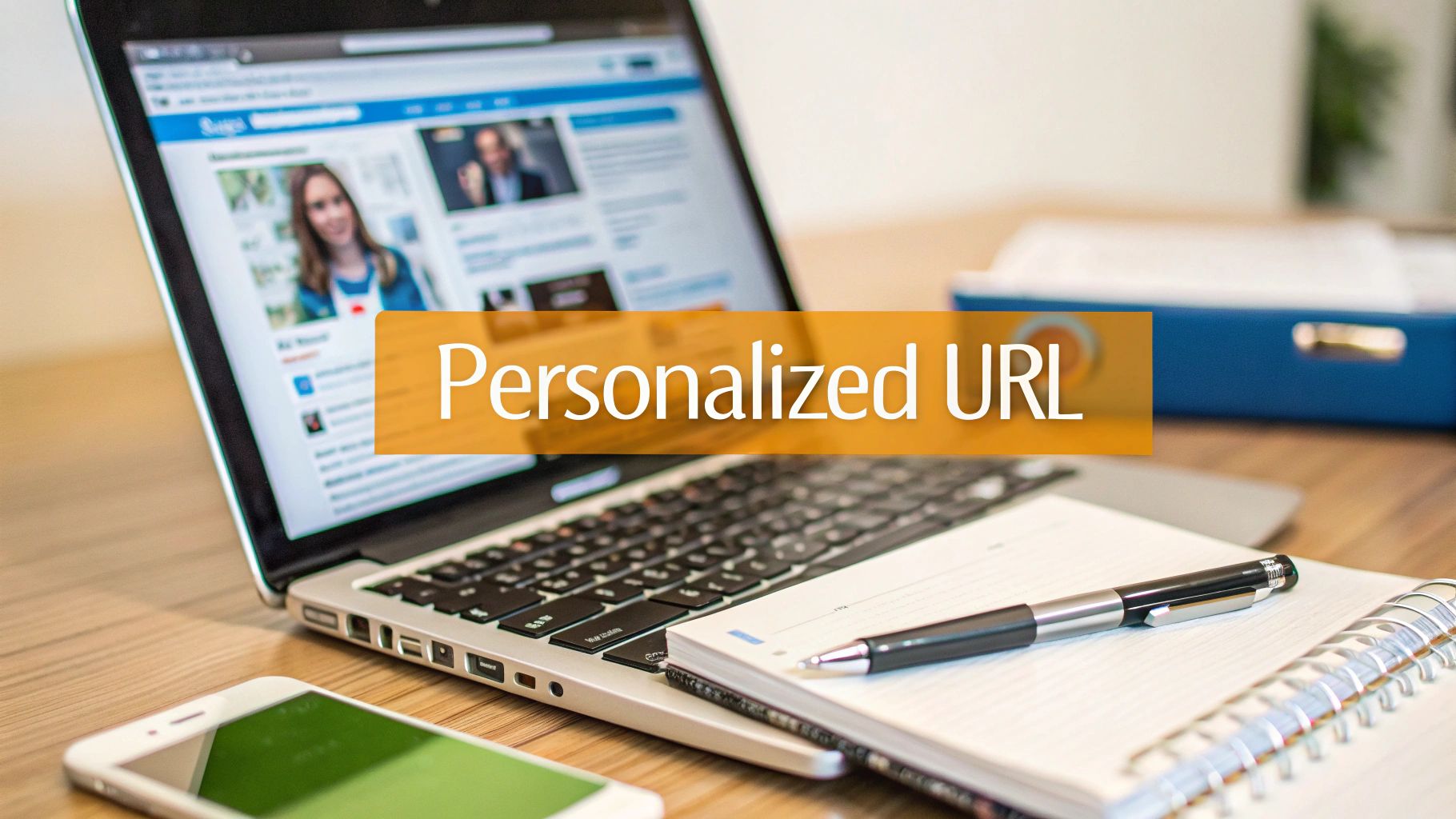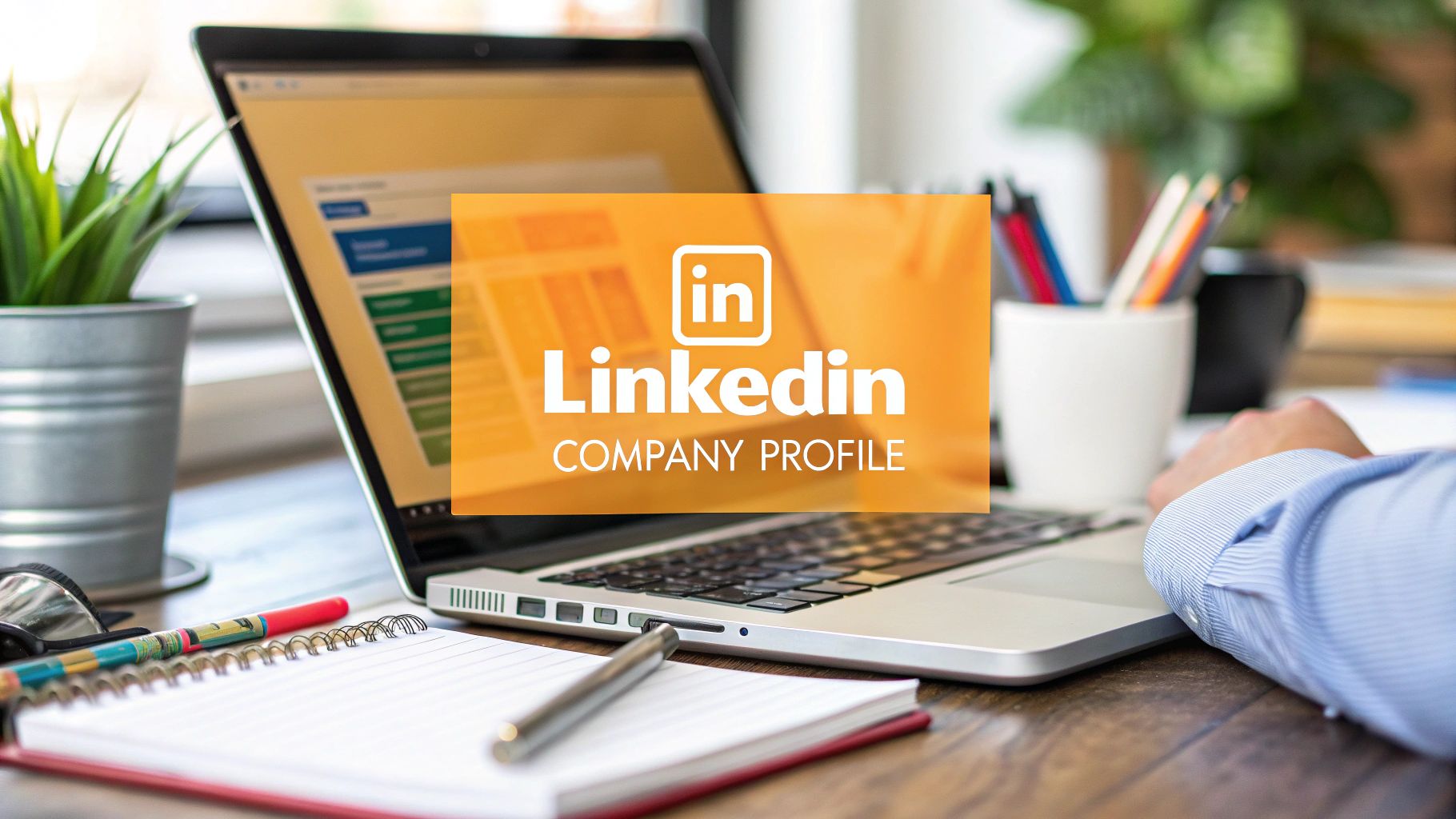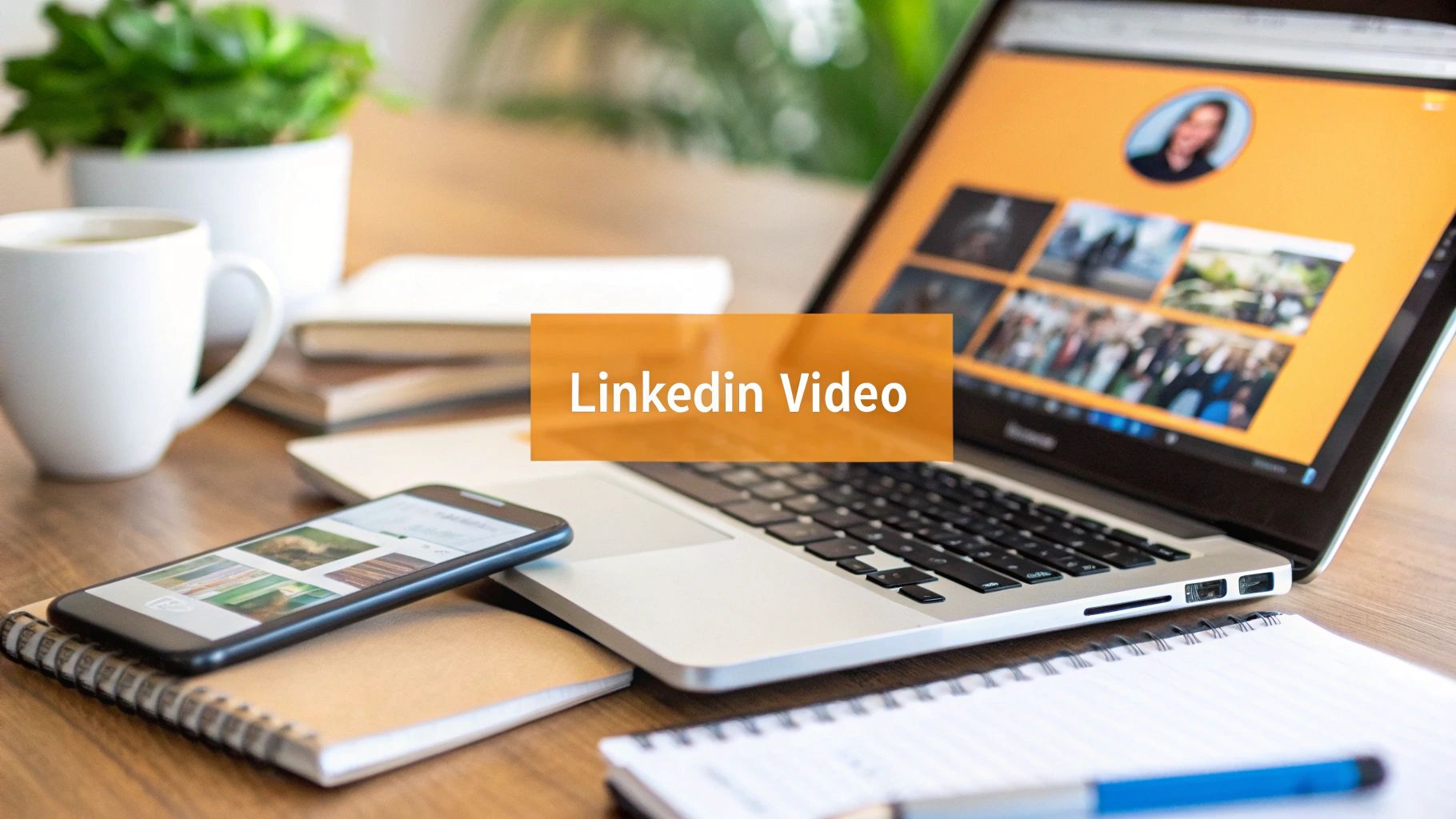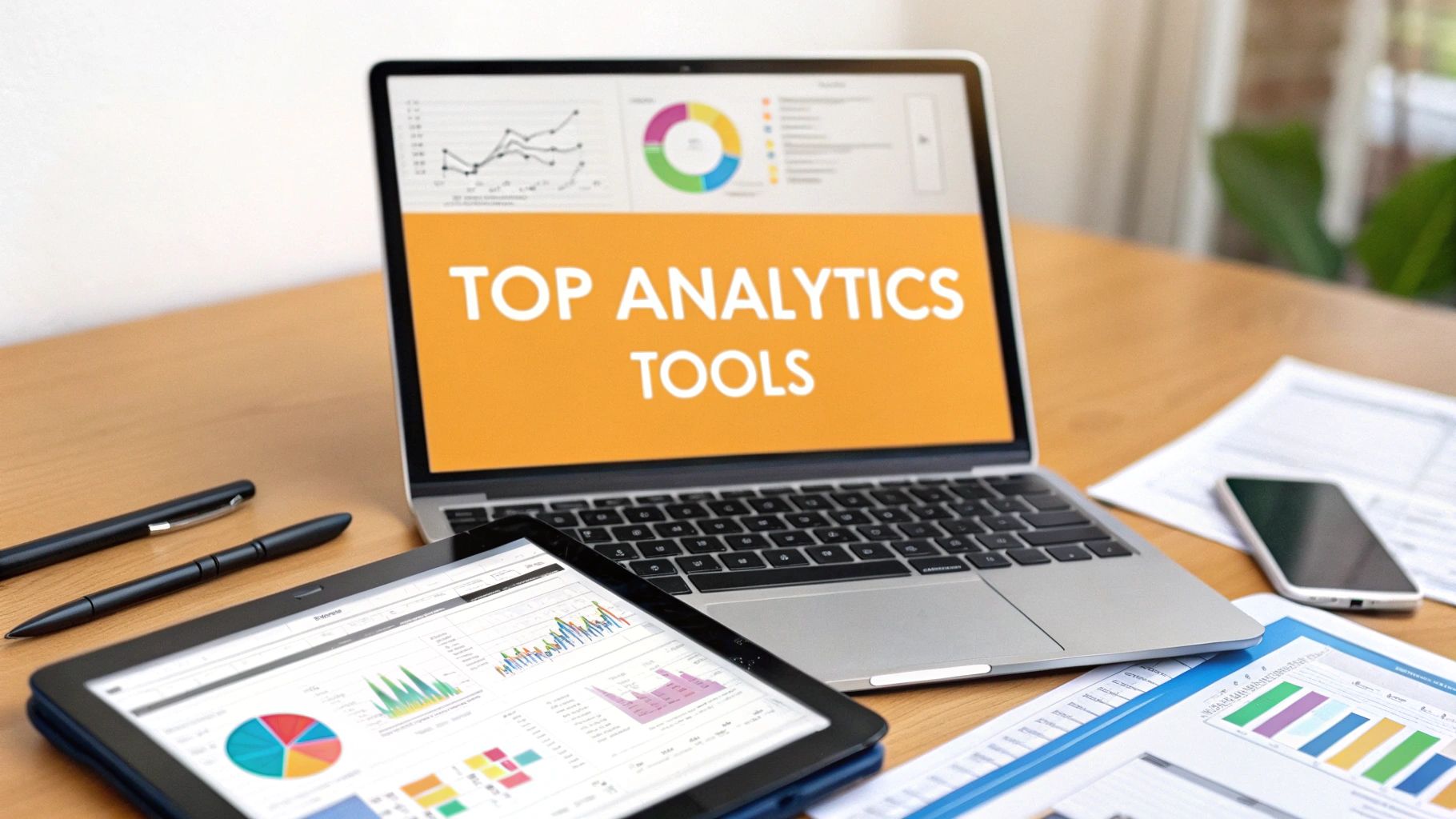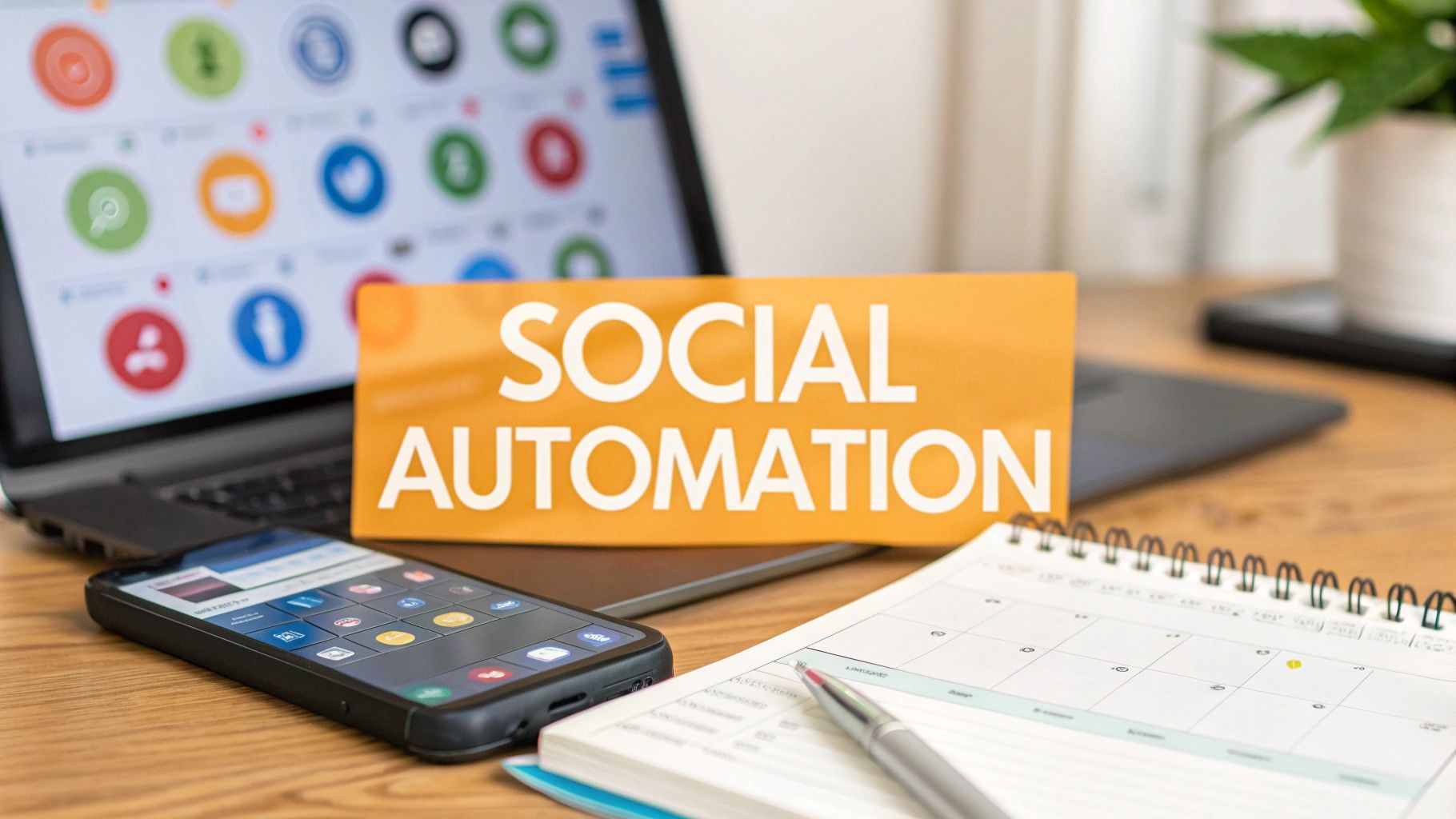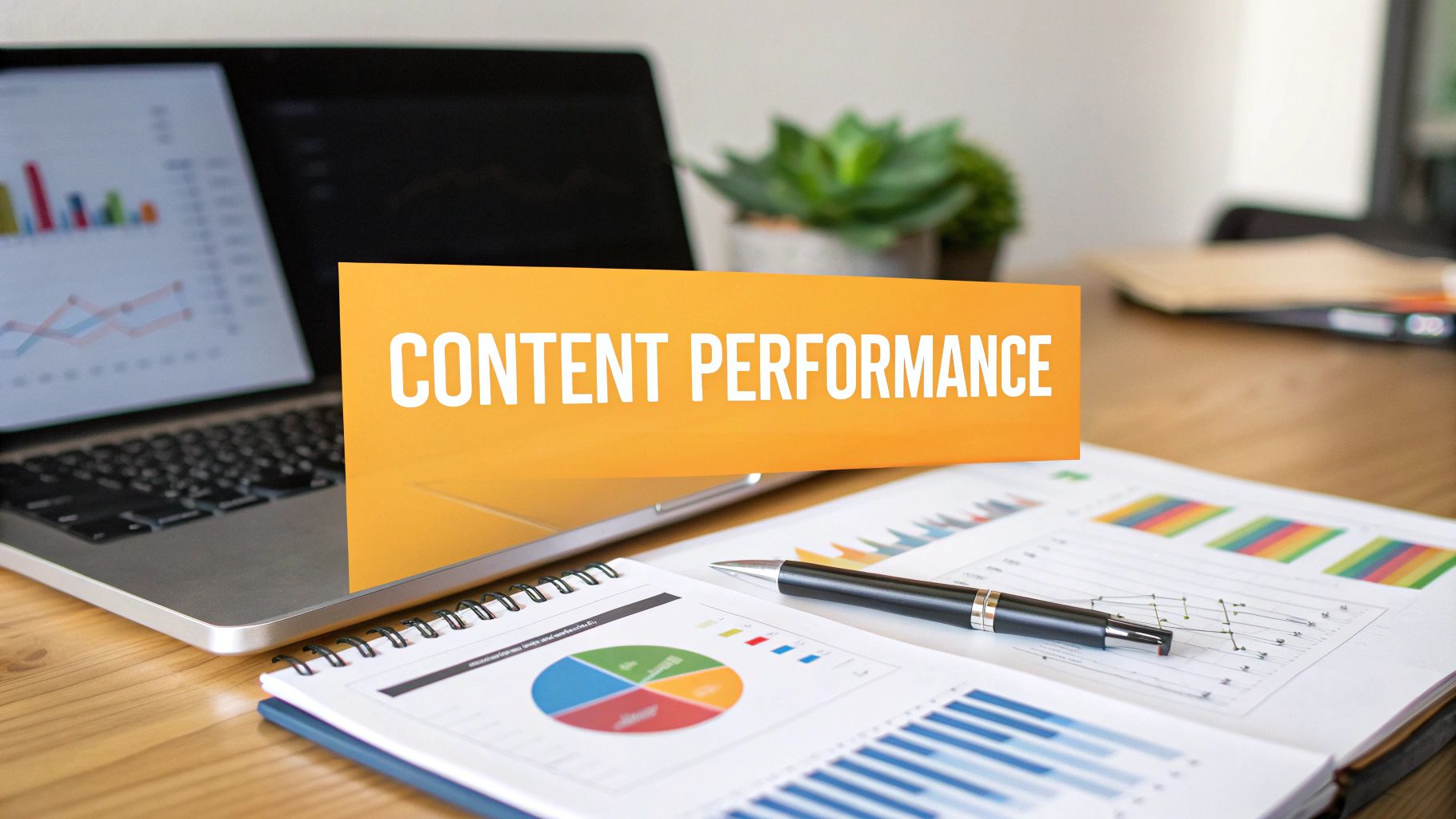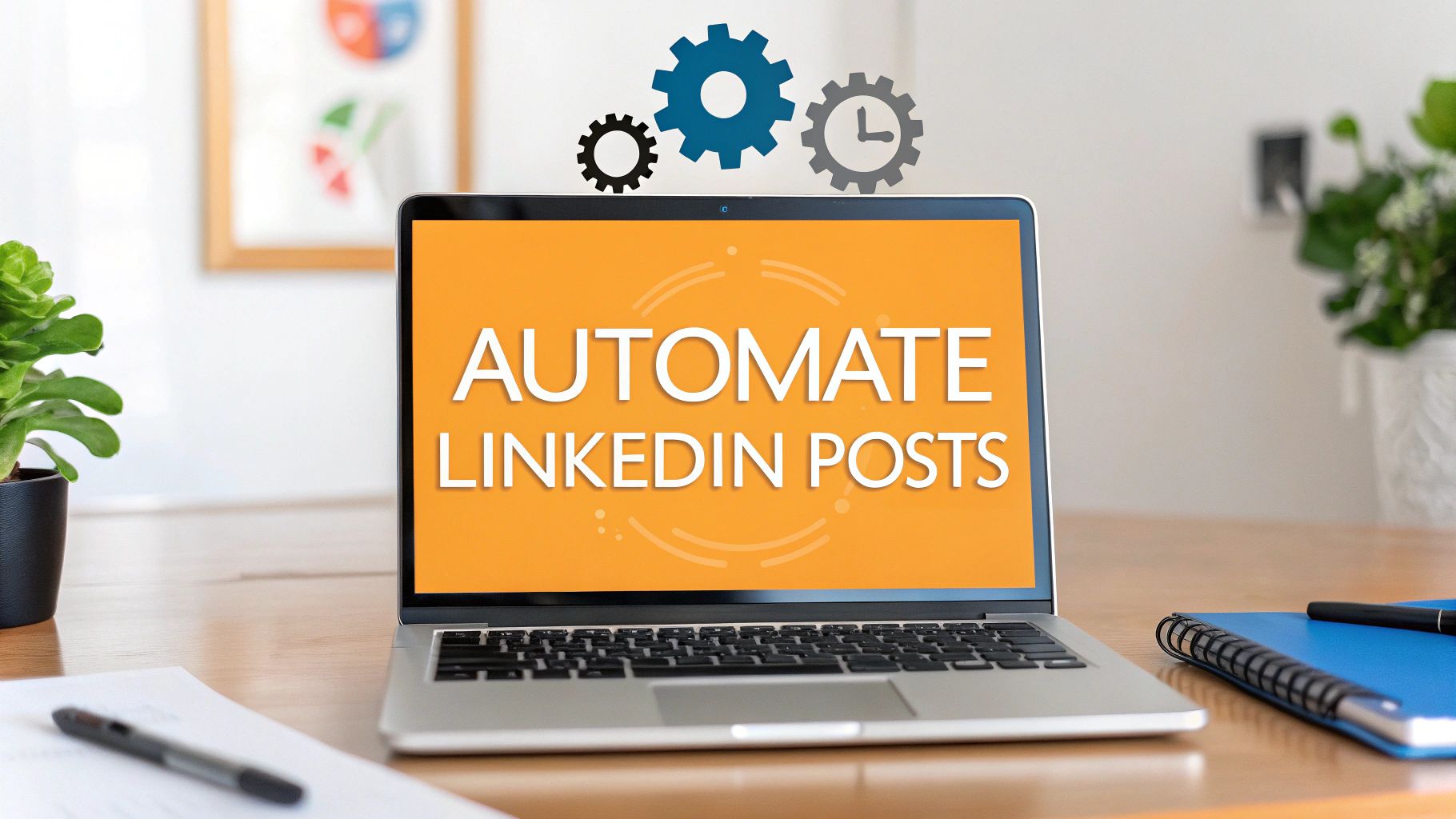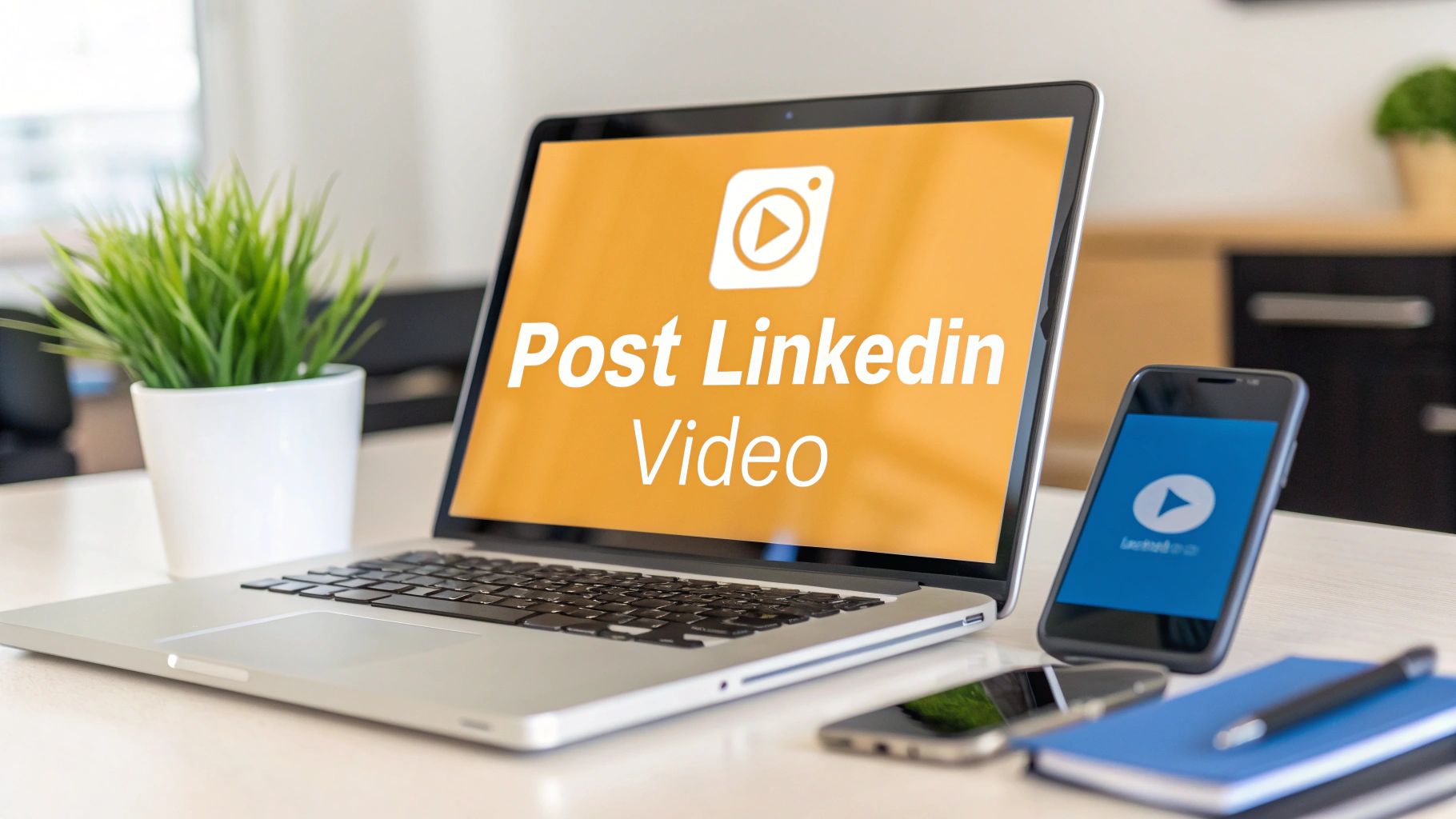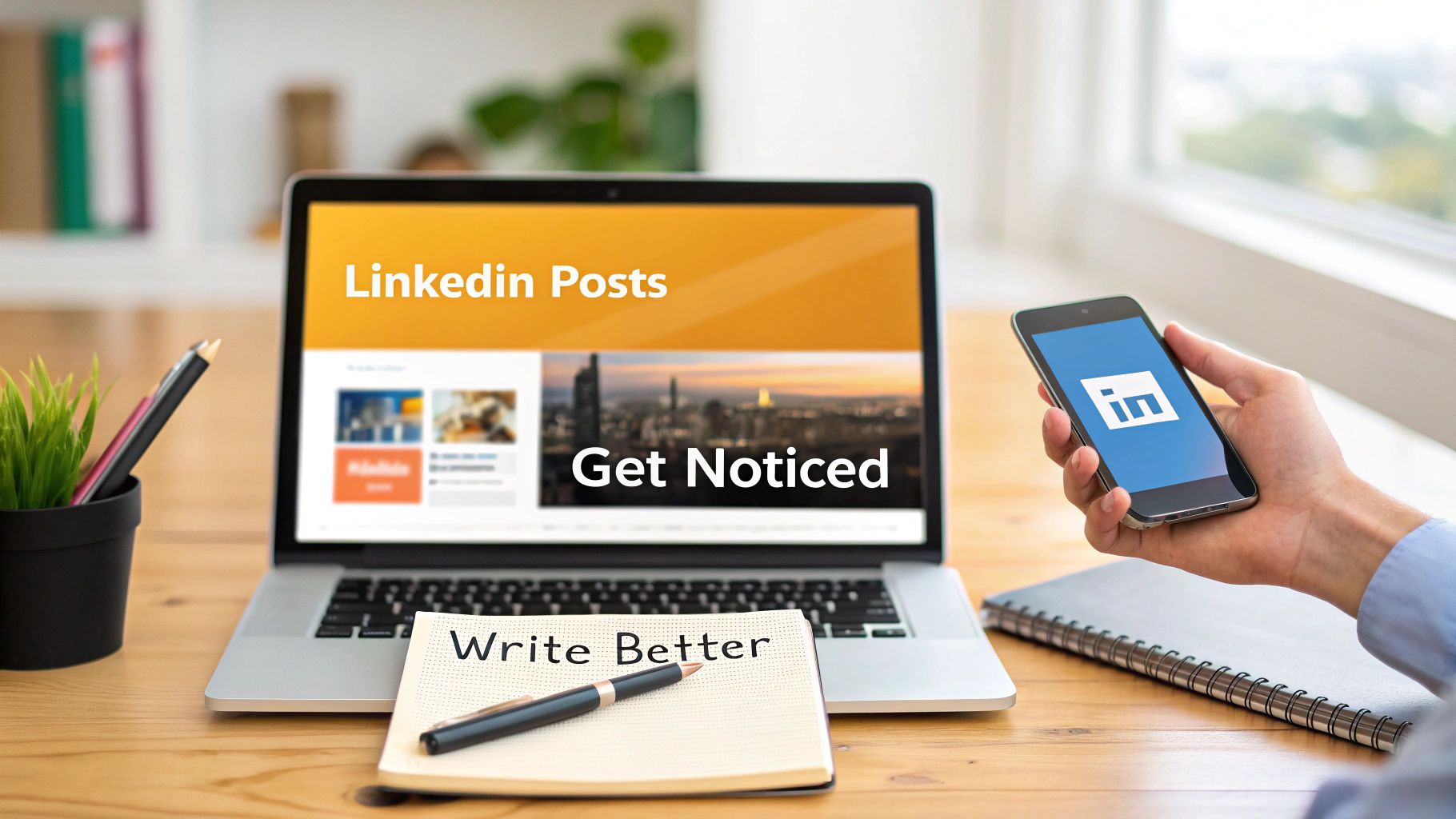Want to write LinkedIn posts that actually get noticed? It all starts with a clear plan. You need to know exactly who you're talking to, decide what you want each post to achieve, and then write an opening line that stops the scroll.
This isn't just about sharing random thoughts. It's about strategic communication that builds your brand and starts real conversations.
The Strategic Groundwork for High-Impact LinkedIn Posts
Before you even think about writing, you have to lay the foundation. Just tossing content into the void and hoping for the best is a fast track to getting zero engagement. The people who win on LinkedIn all have a clear strategy, and it always boils down to two things: audience and goal.
First Things First: Define Your Audience
Who are you actually trying to reach? Just saying "professionals" is way too vague and won't get you anywhere.
You have to get granular. Are you trying to connect with junior-level marketers? Seasoned VPs of Sales? Or maybe startup founders scrambling for their next funding round? Each of these groups has completely different problems, goals, and even a different way of speaking.
Thinking this through is non-negotiable. If you need a hand with this, check out this excellent guide on how to effectively define your target audience. Getting inside their heads is the only way to create content they'll actually find valuable.
This simple visual breaks it down perfectly: know your audience, then set your goal.
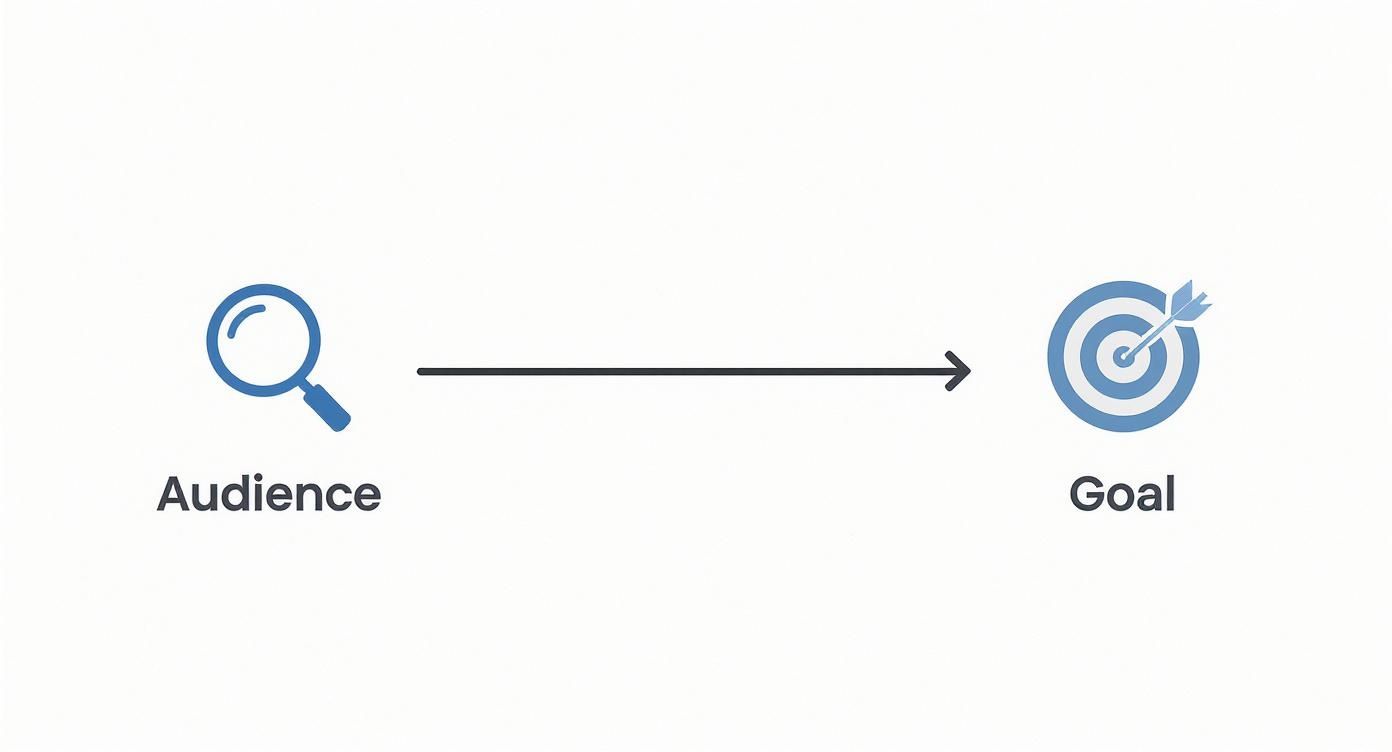
It’s a straightforward flow: understanding who you're talking to directly shapes what you want to achieve with your post.
Set a Crystal-Clear Goal for Every Single Post
Okay, so you know who you’re talking to. Now, what do you want them to do after reading your post? Every single piece of content needs one clear purpose. No exceptions.
- Want to start a discussion? Ask a sharp, open-ended question about a pain point everyone in your industry faces.
- Trying to build credibility? Share a unique insight from a recent project, a quick case study, or a hard-won lesson.
- Need to drive traffic? Offer up a genuinely useful resource (like a template or guide) and tell them exactly why it’s worth their time to click.
To get you started, here's a quick cheat sheet for a winning post framework.
Quick-Start Guide to a Winning LinkedIn Post
| Element | Why It Matters | Quick Tip |
|---|---|---|
| Clear Audience | Ensures your message is relevant and specific. | Picture one person and write directly to them. |
| Single Goal | Dictates the entire structure and CTA of your post. | Decide: Do you want comments, clicks, or shares? |
| Strong Hook | Captures attention in the first 1-2 lines. | Start with a bold claim, a relatable problem, or a question. |
This table covers the bare essentials. Nail these three things, and you're already ahead of the game.
Remember, your goal defines everything that follows, from that all-important first line to your final call to action. A post built to get comments is going to look and feel completely different from one designed to drive traffic to your website.
And don't forget the power of your personal profile. Posts from individuals get 2.75 times more impressions and a whopping five times more engagement than posts from company pages. That makes getting this strategy right for your own brand absolutely critical.
Your Hook and Narrative: The Make-or-Break Moment
On LinkedIn, you’ve got about two seconds to grab someone's attention. That’s it. If the first couple of lines don’t land, they’re gone. All the brilliant insights you’ve packed into your post? Wasted, lost to the endless scroll.

Think about it—that initial snippet is all anyone sees before they have to click "see more." Your job is to make that click a no-brainer. A solid hook doesn't just ask for attention; it demands it.
Writing an Opener That Stops the Scroll
So, how do you actually write something that stops people in their tracks? It comes down to sparking curiosity, hitting an emotional nerve, or making them feel seen. The best hooks I've seen usually fall into a few tried-and-true categories.
Here are a few angles to consider for your next post:
- The Contrarian View: Go against the grain. Challenge a common industry belief. Something like, "Everyone tells you to hustle 24/7 to get ahead. Here's why that's terrible advice."
- The Shocking Statistic: Numbers make people lean in. Kick things off with, "Over 70% of professionals are disengaged at work. The real reason will surprise you." See? It immediately makes you want to know more.
- The Vulnerable Confession: Nothing connects like a real, human story. "I completely bombed my first big client presentation. It was humiliating, but it taught me everything." That kind of honesty is magnetic.
- The Provocative Question: Get your reader thinking. Ask something that makes them pause and reflect, like, "What’s the single worst piece of career advice you’ve ever received?"
This isn’t about writing clickbait. It’s about making a genuine promise to your reader that what comes next is worth their time. For a masterclass in this, check out these killer examples of LinkedIn posts that absolutely nail the hook.
Weaving a Story That Delivers on the Promise
A killer hook gets them to stop, but a great story makes them stay for the whole show. Once you have their attention, you can't just throw a bunch of random thoughts at them. You need to deliver on that initial promise with a clear, compelling narrative.
An incredibly effective way to structure your post is the classic Problem-Agitate-Solution (PAS) framework. It just works.
The PAS Framework: First, you introduce a Problem your audience knows all too well. Next, you Agitate it—poke the bruise a little by describing the frustrations and consequences. Finally, you ride in with the Solution, offering your unique insight or advice.
This simple arc takes your reader on a journey. It starts by saying, "I get it, I see your struggle," which builds an immediate connection. Then it validates those feelings before offering a clear path forward.
This is how you turn a simple tip into a memorable lesson. You’re not just dumping information; you're building trust and positioning yourself as a credible guide. This is the secret to learning how to write LinkedIn posts that don't just get seen—they get felt.
Choosing the Right Format to Maximize Engagement
You can write the most brilliant hook and tell a compelling story, but if you package it in the wrong format, it’s just not going to land. Think of it like serving a gourmet meal on a paper plate—the presentation kills the experience. The format you choose for your LinkedIn post isn't just about looks; it's a strategic move that directly impacts who sees your content and how they engage with it.

If you're just defaulting to text-only posts every single time, you're leaving a massive opportunity on the table. The LinkedIn feed is a crowded place. Visual variety is what makes you stand out. When you mix up your formats, you not only keep your audience interested but also signal to the algorithm that you’re a creator who offers diverse, high-value content.
Beyond Plain Text: The Top-Performing Formats
Think of LinkedIn's post formats as different tools in your content creation toolkit. You wouldn't use a hammer to turn a screw, right? So why use a simple text post when a carousel could tell your story ten times better?
Let’s break down the heavy hitters and when you should pull them out.
- Carousels (Document Posts): These are absolute gold for breaking down complex topics into simple, swipeable slides. Use them for how-to guides, listicles like "5 Mistakes to Avoid When...", or even to repurpose a slide deck from a presentation. They keep people on your post longer, and the algorithm absolutely loves that dwell time.
- Polls: Need a quick and easy engagement win? Polls are your best friend. They're incredibly low-effort for your audience to participate in, which often leads to a flurry of interaction and gets a conversation started in the comments.
- Video: Video is a true powerhouse on LinkedIn. A short, subtitled clip sharing a quick tip or a behind-the-scenes look at your work can forge a much stronger personal connection than text ever could.
Here's a number that really puts this into perspective: while LinkedIn's average engagement rate hovers around 2.8%, video posts can outperform text-only posts by a factor of five. It's a stark reminder of how much the right format can move the needle on your content's reach and impact. You can see more data like this in this deep dive into LinkedIn statistics.
Making Your Visuals Pop (Even Without a Design Degree)
Don't panic—you don’t need to be a graphic designer to create posts that look good. In fact, simplicity often works best. For carousels, find a clean template that uses your brand colors and a font that's easy to read. The golden rule is to focus on one main idea per slide to keep it from feeling cluttered.
Even a humble text post can be spruced up visually. The length of your post definitely matters, but so does its structure. Use short paragraphs, sprinkle in some bullet points, and use bolding to emphasize key phrases. This breaks up the wall of text and makes your content far easier to skim on a phone. For more specific advice on this, check out our guide on the ideal LinkedIn post character limit, which has some great benchmarks.
By strategically choosing your format, you're doing more than just sharing information—you're creating an experience for your audience. A well-designed carousel educates, a powerful video connects, and a well-timed poll can spark a real community conversation. Start experimenting, see what your audience clicks with, and watch your engagement climb.
Playing Ball With the LinkedIn Algorithm
Okay, so you’ve hit "post." Don't go grab a coffee just yet. This next part is where the real magic happens—making sure people actually see the great content you just created. It's all about understanding how to work with the LinkedIn algorithm, not against it.
Think of the algorithm as a picky but fair curator. Its only job is to show people stuff they’ll find interesting. Your job is to convince it that your post is one of those things. And you have to act fast.

Nail That First Hour
There's a lot of talk about the "golden hour," and for good reason. The first 60 minutes after your post goes live are absolutely critical. Early likes and, more importantly, comments are huge signals to LinkedIn that you've got something good on your hands. The algorithm sees that initial buzz and starts showing your post to more people.
Your mission, should you choose to accept it, is to be glued to your notifications.
When someone comments, jump on it. But please, don't just drop a "Thanks!" and move on. Ask a follow-up question. Challenge their point (politely!). Get a real conversation started. That back-and-forth dialogue is pure gold.
This isn't just a theory; recent algorithm changes have made this even more important. Getting into the comments right away can give your post a visibility bump of up to 35%. You can even breathe new life into an older post by dropping a fresh comment after 8 or 24 hours. Want to go deeper? We've broken down how the latest LinkedIn algorithm works and what it means for your content strategy.
How to Use Hashtags and Tags Without Being Annoying
Hashtags and tags are powerful tools for discoverability, but most people use them wrong. They aren't for stuffing your post with keywords; they're for adding context and pulling the right people into the conversation.
Hashtags: Keep it simple. Stick to 3-5 super-relevant hashtags. I like to use a mix—maybe one broad tag like #Marketing, one niche one like #B2BContent, and a branded one. This tells LinkedIn exactly who to show your post to.
Tagging People: Be thoughtful. Only tag people you've actually mentioned or who have a direct, genuine connection to what you're talking about. Tagging random influencers for visibility is cringey and it almost never works. It just feels spammy.
Here's my rule of thumb: Tag people you genuinely want a response from, not just an impression. Tag a colleague you worked with on the project you're highlighting. Tag an expert whose article you're quoting. Make it make sense.
It's a balancing act. Tagging a few relevant folks (up to five is a safe bet) can kickstart a discussion. But go overboard, and the algorithm will sniff out the inauthenticity and penalize your reach. The real secret to writing posts that blow up on LinkedIn is focusing on real, valuable interaction, not cheap growth hacks. That’s how you build a community, not just an audience.
Crafting a Clear and Effective Call to Action
So, you’ve put in the work. You nailed the hook, shared a great story, and delivered real value. What now? The absolute worst thing that can happen is your reader just nods and keeps scrolling. A great post always points them somewhere.
This is where your Call to Action (CTA) makes its entrance. It’s your moment to turn a passive reader into an active participant. But here's the catch—a clunky or demanding CTA can kill the vibe you just created. The key is to make your request feel like the natural next step, not some abrupt sales pitch.
Moving Beyond Generic Asks
Let's face it, "link in comments" is getting a little tired. We can do better. A powerful CTA is specific, highlights a benefit, and ties back perfectly to the whole point of your post. You've earned their attention; now make your ask count.
Instead of just telling people what to do, frame it around the value they get.
- Weak CTA: "Check out my new blog post."
- Strong CTA: "Want the full 5-step framework I used to get these results? I'm giving away the template in my latest article."
Feel the difference? The first is just a command. The second is an invitation that screams, "Here's what's in it for you!" This simple shift is fundamental to writing LinkedIn posts that actually get people to do something.
The best CTAs don't just tell people what to do; they answer the reader’s unspoken question: "Why should I bother?" Think of your CTA as the bridge from the value you just gave them to the even bigger value you’re offering next.
Matching Your CTA to Your Goal
The kind of CTA you use has to sync up with the goal you set for the post in the first place. A mismatch here just feels weird and can sabotage your engagement. If your post is meant to start a conversation, don't end it with a hard sell for your course.
Here’s a quick guide to aligning your CTA with your objective:
If your goal is to spark a discussion: Your CTA should be an open-ended question that’s easy and inviting to answer. Ditch the simple yes/no questions. Instead of "Do you agree?" try something like, "What’s the one piece of advice you’d add to this list?" This gets people thinking and sharing real insights, which the algorithm loves.
If your goal is to drive traffic: Be crystal clear about the benefit of clicking that link. Is it a guide? A tool? A deep-dive case study? Tell them! For instance, "I broke down this entire process in a 10-minute video guide. I’ll drop the link in the comments so you can watch."
If your goal is to build community: Ask people to share their own stories or tag someone who’d benefit from the post. A CTA like, "Tag a manager who needs to see this," is brilliant because it helps you reach new people through the trusted networks of your current audience.
When your CTA becomes a logical and helpful final step, it stops feeling like a self-serving ask. Instead, it becomes one last piece of value you're offering your reader.
Got Questions About Writing for LinkedIn? We've Got Answers.
Alright, so you've got the basics down, but let's be real—the devil is always in the details. When you're trying to figure out how to write LinkedIn posts that actually get noticed, a few key questions always seem to pop up.
Think of this as your go-to cheat sheet. These are the practical, in-the-trenches questions that can mean the difference between a post that resonates and one that just floats by.
So, How Often Should I Actually Post on LinkedIn?
This is probably the most common question I hear, and the answer isn't what most people expect. Here it is: consistency beats frequency, every single time.
Seriously. It’s way better to share one genuinely helpful, well-crafted post each week than it is to spam the feed with five half-baked updates just for the sake of "being active." If you're looking for a solid starting point, aim for 3-5 quality posts per week. That’s a great rhythm to stay on your network's radar without completely burning yourself out.
But here's the real pro-tip: your analytics are your best friend. Pay attention to what your audience is telling you. Are your Tuesday morning posts getting more love than your Thursday afternoon ones? Your data will eventually show you the perfect posting schedule for your specific network. Let it guide you.
What’s the Perfect Length for a LinkedIn Post?
There’s no magic number here, but there’s definitely a sweet spot. I've found that posts hanging out in the 1,200 to 2,000 character range (think 200-300 words) tend to do really well. It's just enough space to share a meaningful story or a solid piece of advice without making your reader's eyes glaze over.
That said, don't get obsessed with the character count. A short, snappy post with a killer image or a thought-provoking question can easily outperform a longer one.
The only rule that matters for post length is this: make every single word earn its place. Your post needs to be long enough to be valuable but short enough to keep people hooked right to the end. Clarity and scannability are everything.
Here are a few simple formatting tricks to make any post easier to read:
- Keep your paragraphs short—two or three sentences, max.
- Use bullet points for lists or key takeaways.
- Bold important phrases to make them pop.
- Don't be afraid of white space! It makes your content so much less intimidating.
How Do I Know if My Posts Are Even Working?
Success is more than just a big view count or a flurry of likes. A truly successful post is one that actually accomplishes what you wanted it to do in the first place.
You have to look past the surface-level numbers and tie your results back to your original goal.
Here’s a better way to think about it:
- Goal: Start a conversation? Then your most important metric is the number and quality of comments. Are people just dropping a "great post!" and running, or are they actually adding to the discussion and asking questions? That's the real gold.
- Goal: Drive traffic to your site? The only number that matters is your click-through rate (CTR). LinkedIn analytics will show you this. A high CTR tells you that your hook and call-to-action were on point.
- Goal: Build your personal brand? Keep an eye on metrics like an increase in profile views, a jump in new connection requests, or DMs from people who mention your content. These are the signs that you're building a reputation as the go-to expert.
Feeling the pressure to create but staring at a blank page? That’s exactly why we built RedactAI. Our tool gets to know your unique voice and expertise, then generates dozens of powerful LinkedIn post ideas and drafts in just a few minutes. You'll never run out of great things to say. Stop struggling and start creating posts that deliver real results. Give RedactAI a try for free.




